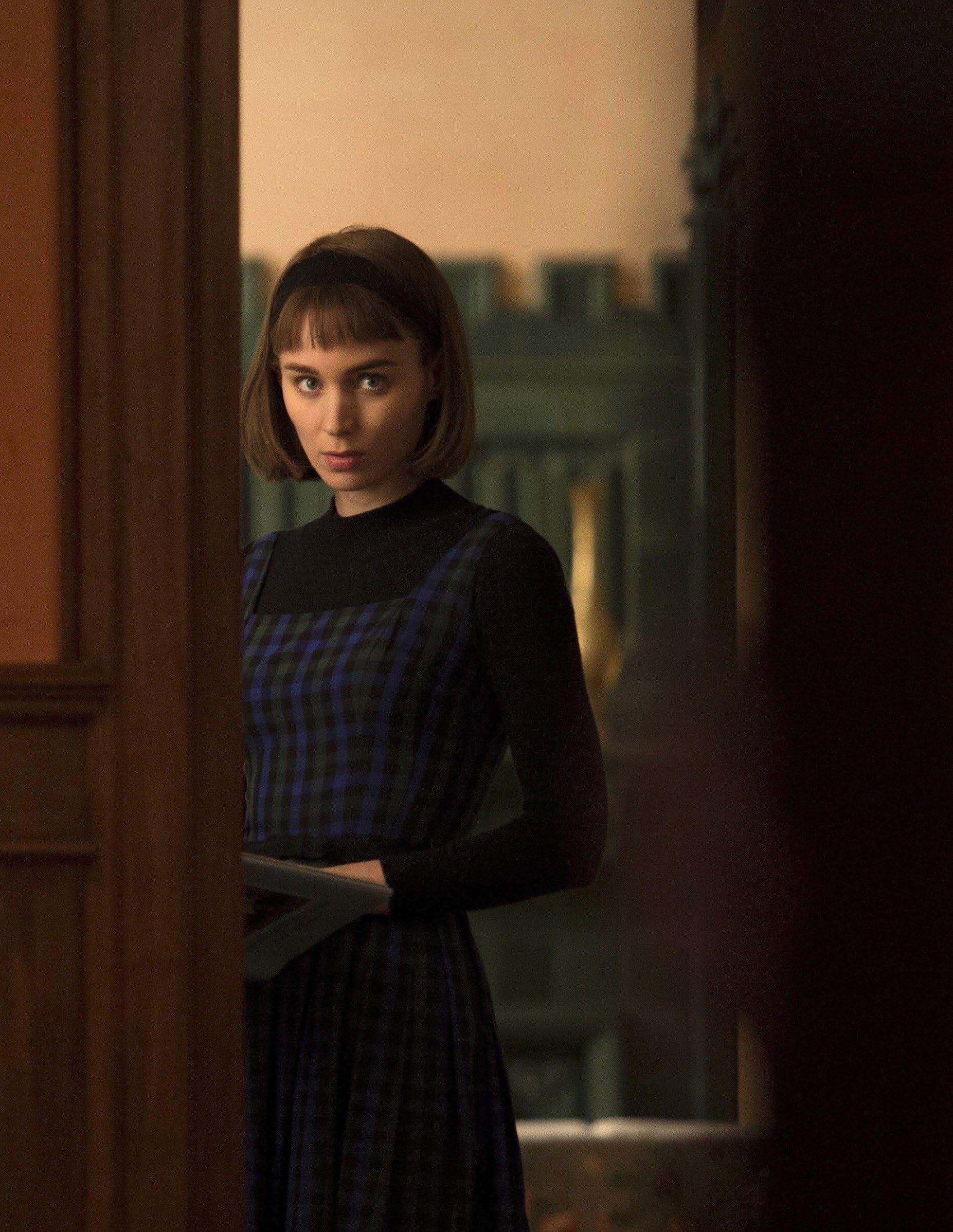
Vol. 07 No.01 I Spring 2022
The Journal of Film & Visual Narration

CONTENTS
Vol.07, No.01 | Spring 2022
OVERVIEW
ii About MSJ
iii Letter from the Editor Greg Chan
iv Contributors
ARTICLES
01 Naderi’s The Runner: Trauma of Modernity and Desire for the Machine Amir Barati
FEATURETTES
14 The End of Everything: Millennium Anxiety in Gregg Araki's Nowhere Henrique Brazão
18 A Close Look at the Perception of Power in Carol
Alexandria Jennings
22 The Precise Composition of The Diary of Anne Frank
Marshall Deutelbaum
25 Cinematic Isolation and Entrapment in The Lobster Mazyar Mahan
INTERVIEWS
29 An Interview with Director Cathy Brady Paul Risker
UNDERGRADUATE SCHOLARSHIP
34 Creating Space for Belongingness in Midsommar Matthew Scipione
BOOK REVIEWS
39 Breaking Bad and Cinematic Television Paul Tyndall
ANNOUNCEMENTS
42 Open Call for Papers
43 About the Journal
MISE - EN - SCÈNE i
Gregg Araki's Nowhere. Fine Line Features, 1997.

EDITOR-IN-CHIEF
Greg Chan, Kwantlen Polytechnic University (KPU), Canada
ADVISORY BOARD
Kelly Ann Doyle, KPU, Canada
Richard L. Edwards, Ball State University, USA
Allyson Nadia Field, University of Chicago, USA
David A. Gerstner, City University of New York, USA
Michael Howarth, Missouri Southern State University, USA
Andrew Klevan, University of Oxford, United Kingdom
Gary McCarron, Simon Fraser University, Canada
Michael C.K. Ma, KPU, Canada
Janice Morris, KPU, Canada
Miguel Mota, UBC, Canada
Paul Risker, University of Wolverhampton, United Kingdom
Asma Sayed, KPU, Canada
Poonam Trivedi, University of Delhi, India
Paul Tyndall, KPU, Canada
REVIEWERS
Michael Howarth, Missouri Southern State University, USA
Michael Johnston, Kutztown University of Pennsylvania
Dan Lett, KPU, Canada
Mazyar Mahan, Chapman University, USA
Gary McCarron, Simon Fraser University, Canada
Christina Parker-Flynn, Florida State University
Novia Shih-Shan Chen, KPU, Canada
COPYEDITORS
Heather Cyr, KPU, Canada
Janice Morris, KPU, Canada
Robert Pasquini, KPU, Canada
LAYOUT EDITOR
Patrick Tambogon, Wilson School of Design at KPU, Canada
WEBMASTER
Janik Andreas, UBC, Canada
OJS CONSULTANT
Karen Meijer-Kline, KPU, Canada
The views and opinions of all signed texts, including editorials and regular columns, are those of the authors and do not necessarily represent or reflect those of the editors, the editorial board or the advisory board.
Mise-en-scène: The Journal of Film & Visual Narration is published by Kwantlen Polytechnic University, Canada
WEBSITE
journals.kpu.ca/index.php/msq/index
FRONT COVER IMAGE
Courtesy of Alamy
BACK COVER IMAGE
Courtesy of Jake Hills on Unsplash
SPONSORS
Faculty of Arts, KPU KDocsFF
KPU Library
English Department, KPU
CONTACT
MSJ@kpu.ca
SOCIAL MEDIA
@MESjournal facebook.com/MESjournal UCPIPK-f8hyWg8QsfgRZ9cKQ
ISSN: 2369-5056 (online) ISSN: 2560-7065 (print)


Vol.07 No.01 | Spring 2022 ii About MSJ
Dear Reader:
Welcome to the Pride Edition of MSJ: a special collection reflecting on LGBTQIA2S+ resistance, resilience, and representation.
The dossier before you puts the spotlight on LGBTQIA2S+ Otherness and queer spaces in films ranging from Todd Haynes’s Carol (2015) and Ari Aster’s Midsommar (2015) to Yorgos Lanthimos’s The Lobster (2015) and Gregg Araki’s Nowhere (1997). Coinciding with annual Pride celebrations—June being Pride Month in Canada and elsewhere internationally—Issue 7.1 invites you to invest in LGBTQIA2S+ and queer adjacent narratives captured in the frame. As with all of our journal’s themes, Pride emerged organically to become the issue’s unifying voiceover.
Another unifying element is Issue 7.1’s focus on the mise-en-scène featurette. Typically, our issues are anchored by feature-length articles. However, our Pride edition specializes in concentrated film analyses at the level of the frame. I invite you to immerse yourself in our collection of five featurettes that break down the artistry of a scene through individual frames. One of those featurettes is by Matthew Sciopione, this edition’s undergraduate scholar. If you’re looking for a long-form analysis, we have you covered with Amir Barati’s article on Naderi’s The Runner.
On behalf of everyone here at MSJ, I am proud to announce that KPU’s Faculty of Arts has joined us as our Headlining Sponsor and KPU’s Department of English—the journal’s home base for the last seven years—has come aboard as our Premier Sponsor. Special thanks to Dr. Greg Millard, Pro Tem Dean of Arts, and Dr. Robert Dearle, English Department Chair, for their generous support. With their sponsorship, the MSJ team looks forward to sharing film studies scholarship with you for many years to come.
Finally, I would like to offer a sneak peek at our upcoming issue (7.2, Winter 2022), which will be a themed edition on horror guest edited by Michael Howarth from Missouri Southern State University. Dr. Howarth is a long-serving member of the MSJ advisory board and review team who specializes in filmic horror. His themed call for papers has resulted in an exciting collection of articles and reviews (film festival and book), along with a video essay and an interview with Dacre Stoker (great grandnephew of Bram Stoker). I am grateful to Dr. Howarth for stepping in as guest editor while I am on sabbatical.
With Pride,
Greg Chan Editor-in-Chief
MISE - EN - SCÈNE iii
LETTER FROM THE EDITOR

Amir Barati is an interdisciplinary scholar interested in American minority literature, neuro-psychoanalytic theory, and film studies. His research focuses on the representations of traumatic bodies in American diasporic literature and films. Amir is currently a graduate instructor and PhD candidate in English and Humanities at the University of Missouri in Kansas City. His former publications address diverse issues including processual subjectivity and plasticity, apocalyptic imaginations, and body politics in American and British fiction and films. Amir has been editing for Kansas City Voices, Tête-à-Tête (published by Louisiana State University), and UMKC’s Journal of Interdisciplinary Research.
HENRIQUE BRAZÃO

Born in 1993, Henrique Brazão is a Portuguese filmmaker, independent film scholar and activist based in Lisbon. With a BA in Screenwriting from Lisbon Film School (ESTC) and a Masters degree in Communication Sciences from Lisbon’s NOVA University, he has written and directed two short fiction films –Em Junho (2019) and Farol (2022) – both about gaining freedom through sensory experience. He is currently preparing an application for a PhD program, intending to produce solid written work about cinema at the turn of the millennium.
Vol.07 No.01 | Spring 2022 iv
AMIR BARATI
CONTRIBUTORS

Marshall Deutelbaum is Professor Emeritus in English at Purdue University. He is co-editor with Leland Poague of A Hitchcock Reader, 2nd ed. (Wiley-Blackwell, 2009). Professor Deutelbaum was on the staff of the Film Department of George Eastman House during the 1970s. Among his curatorial responsibilities was teaching courses in film history at the University of Rochester. From 1980 until his retirement in 2005 he taught courses in film history and theory in the English Department at Purdue University. His many publications include number on the films of Hong Sangsoo. This essay is a portion of his ongoing research into the visual logic of widescreen filmmaking. His most recent publication is “’Why Does It Look like This?’ A Visual Primer of Early CinemaScope Composition,” published online in Movie: A Journal of Film Criticism. It is available at https://warwick.ac.uk/fac/arts/scapvc/ film/movie/contents/whydoesitlooklikethis_v04.pdf

Alexandria Jennings is a recent graduate of Youngstown State University where she earned her Master of Arts in English. In the fall she will be attending The University of Pittsburgh as a doctoral student, focusing her work in the field of composition and rhetoric. Her master’s work was situated in the disciplines of discourse theory, film studies, queer theory, and early American literature. During her time in the program, she taught in the university’s composition program which led to the development of a case study aiming to investigate the common misconceptions about writing that first-year writers possess. Alexandria has also spent a great deal of time conducting research in the realm of queer theory which she attributes to helping forge her scholarship in queer film. Her scholarship on lesbian power dynamics and autonomy on screen in the film, Carol (2015) has prompted her to work on other film-based projects concerning the intersection of imperialism and satire in both visual and written texts. This is her first academic publication.
MISE - EN - SCÈNE v Contributors
MARSHALL DEUTELBAUM
ALEXANDRIA JENNINGS

Mazyar Mahan is a Teaching Associate and PhD student in Visual and Performing Arts at the University of Texas at Dallas, where he teaches Transnational Film and Video. His research interests include global and transnational cinemas, cultural studies, and contemporary Iranian cinema. Mazyar has presented his research at conferences such as the Society for Cinema and Media Studies (SCMS), the National and the Southwest PCA, and the University of Southern California Film Studies Conference. His scholarly work appeared in journals such as The Spectator

Paul Risker is an independent scholar, freelance film and literary critic, and interviewer. Outside of editing MSJ’s interview and film festival sections, he mainly contributes to PopMatters, although his criticism and interviews have been published by both academic and non-academic publications that include Cineaste, Film International, The Quarterly Review of Film and Video, and Little White Lies. He remains steadfast in his belief of the need to counter contemporary cultures emphasis on the momentary, by writing for posterity, adding to an ongoing discussion that is essentially us belonging to something that is bigger than ourselves.
Vol.07 No.01 | Spring 2022 vi Contributors
MAZYAR MAHAN
PAUL RISKER
MATTHEW SCIPIONE

Matthew Scipione is a writer and director. He earned his Bachelor of Arts at Curry College, where he majored in Communication with a concentration in Film Studies. His essay “Transnational Filmmaking: The Intersubjective Gaze in Desierto” was published in Film Matters earlier this year. Furthermore, his short film King of the Imaginations premiered at IFFBoston this spring. King of the Imaginations is currently being submitted to festivals, as he develops his forthcoming project.

Paul Tyndall completed a PhD in English at Dalhousie University in Halifax, Nova Scotia. He currently teaches literature and film in the Department of English at Kwantlen Polytechnic University in Surrey, B.C. His main teaching and research interests include contemporary American literature and film and Shakespeare on film and television. He is currently engaged in a book-length study on representations of Shakespeare's history plays on film and television. In addition to his teaching and research, he serves on the advisory board of Mise-en-scène: The Journal of Film & Visual Narration.
MISE - EN - SCÈNE vii Contributors
PAUL TYNDALL

Vol.07 No.01 | Spring 2022 viii
Naderi’s The Runner
Trauma of Modernity and Desire for the Machine
BY AMIR BARATI University of Missouri
ABSTRACT
Amir Naderi’s The Runner (1984) heralds a golden age in Iranian cinema. The film portrays the extensive historical rupture caused by the violent force of an imported modernity introduced to the Iranian traditional society, and how desiring bodies in a developing country are breached in competition with the western machine. A unique product of Iranian cinema, the film depicts a nation’s optimistic quest for the synchronization of parallax ways of being. In other words, it echoes the Iranian endeavor to emerge from local convention and accept the extrinsic intruder. Simultaneously, while showcasing the first modern Iranian city, The Runner displays the historical turmoil that bloody wars produced for the native population, generating an ambivalent yet precise image of a war-torn society transitioning toward modernity.
INTRODUCTION
Amir Naderi’s The Runner (1984) heralded a golden age in Iranian cinema. The film was among the first Iranian productions to win an international award after the 1979 Islamic Revolution.1 Yet The Runner never received adequate critical attention for its historical and psychosocial significance. Most scholarship on the film either focuses on its autobiographical implications, which reference the director’s personal life and his childhood, or stresses the ideological shadow of the Islamic Revolution. These readings have distracted from a genuine analysis of The Runner as a philosophical contemplation on a society on the cusp of a critical era, in the midst of a huge modernization project, and facing traumatic upheavals, political revolution, and constant bombardment by one of the most powerful militaries of its time: Saddam Hussein’s Ba’athist army of Iraq. The movie should be read as a meditation on the material impacts of historical events and social conditions on human bodies in a Middle Eastern context.
The Runner reveals the story of a teenager named Amiro (Majid Niroumand), who lives in a slum in a hot and humid Iranian southern port city—likely Ābādā n. Talented, resolute, peculiar, and independent, Amiro—an orphan—is highly competitive and ready to fight for his rights. He waves at ships leaving the harbour and runs to visit his favourite airplanes, collecting their images. He makes a living through various jobs including garbage collecting, shoe-shining, and selling ice water. In a sense, the film is a portrayal of Amiro’s love for huge machines and his efforts to win the demanding games he plays with other children. Initially, he loses these games, but after relentless determination, he wins the last one. Through all of this, he also manages to go to school and learn the Persian alphabet.
Hamid Nafisi, a prominent critic of Iranian transnational cinema, views The Runner on the backdrop of the messianic ideologies of the Islamic Revolution (213). He considers the
1 The Runner won the Golden Montgolfiere in Nantes Three Continents Festival in 1985.
MISE - EN - SCÈNE 01
ARTICLE
Naderi’s The Runner : Trauma of Modernity and Desire for the Machine
film a “proto-exilic movie” and one of “Iranian cinema’s most graphic inscriptions of the desire to escape the homeland for foreign lands” (505). He also assumes the film foreshadows Naderi’s immigration from Iran years after its production. A host of other established Iranian critics share this view, observing The Runner as an expression of the desire to depart from a troubled country. On the other hand, S. Zeydabadi-Nejad notes how the film coincides with “the values of the Islamic regime for being about the lives of mostada’fin (the downtrodden)” and the working class who formed the Islamic Revolution (380). Since the movie was released only five years after the 1979 Islamic revolution and was funded by a public educational institution, a fair number of other critics have overlooked the film’s broader historical appeal and have considered it to be a direct political response to the Islamic Revolution.
Kamran Rastegar is one of the rare scholars who briefly comments on the film’s historical references, pointing out traces of the traumatic Iran-Iraq war. Rastegar writes, “The Runner represents a sublimated response to the effects of the war” (146). He highlights the protagonist’s quest for a new subjectivity as a tale of becoming. Far from the typical politically motivated
stratified between affluent foreigners and local children who live on the streets and make a living collecting recyclables? Why is the land on fire while children run after ice? Responses to these questions require a thorough exploration of the social condition that produced this lifestyle and the director’s worldview. I aim to explore the traumatic history of the society illustrated by Naderi in The Runner and examine the intellectual and cinematic choices the director and his crew made in the production of the film. Believing that “the truth of narrative isn’t in the fact-checking, but in the trauma it circles” (Richardson 505), I argue that Naderi’s film represents the extensive historical rupture as caused by the violent force of modernity imported into traditional Iranian society and how that society’s desiring bodies are breached while competing with the Western machine. Modern machinery and an accompanying contemporary Western lifestyle were introduced to traditional Iranian society mainly through the force of the military or via interactions with semi-colonial industries.2 The desirable power of the modern machine and the violent force of its semi-colonial introduction created a traumatic ambivalence that I will try to articulate in this paper.
Modern machinery and an accompanying contemporary Western lifestyle were introduced to traditional Iranian society mainly through the force of the military or via interactions with semi-colonial industries.
characterizations of the era, the film propagates a progressive and processual subjectivity that is unique in Iranian cinema of the time (Barati and Eslamieh 121). This rare critical standpoint is echoed in Alla Gadassik’s views. Gaddassik argues that The Runner is preoccupied with a kind of cultural displacement and fragmentation which “cannot and will not be remedied through migration elsewhere” (482). For Gaddassik, the fact that Amiro is always living on the margins is of supreme importance to the overall philosophy of the text (477). Nevertheless, the film offers a much more sophisticated perception of the subject’s position within the temporal displacement and historical rupture experienced by Southern Iranian communities.
Moving beyond an analysis of The Runner as a production of its auteur director who comments on it from an autobiographical standpoint, many fundamental questions emerge for the viewer: why is Amiro always running? How should we interpret his fetishistic affection for airplanes and ships? Why is he parentless and living alone? What is the reason behind the heavy presence of machinery? Why is this colonized society
This approach is informed by Jacques Lacan’s argument in Seminar XI (1973) where he discusses the human encounter with modernity and how the automaton fashioned a traumatized modern mentality. According to Lacan, modernity’s production of massive machinery introduced a new aspect of “the real” to humanity. For him, the “real is that which always lies behind the automaton” (55). The real as an encounter causes an unassimilable rupture in the symbolic register of subjects. Based on this viewpoint, the introduction of modern machinery to human life created a new paradigm, causing a historical rupture in the human’s consciousness and signaling a new era that radically diverged from past ones. Therefore, modern subjects—whose previous stories about themselves do not work anymore—use their bodies to recreate and re-narrate themselves in a bid to work through this historical trauma and fill the psychosocial gaps produced by the rupture.
In this respect, The Runner is a materialist contemplation on the emergence of modernity and modern consciousness as well as the ruptures it produced in Iranian society. The film
2 I avoid using the term colonial or postcolonial because Iran was never really colonized in the true sense of the word, as compared to the way India was colonized by Britain or parts of Africa or America were colonized by Europeans. The presence of foreign forces in Iranian contemporary history has always mainly been limited to bordering regions. Thus, the term semi-colonial refers to the temporary presence of foreign military and tradesmen with colonial intentions and their conflicts with the natives in the regions.
Vol.07 No.01 | Spring 2022 02
reveals the historic epiphany offered to Iranians that coaxed them to master the discourse of the machine as a prerequisite to dealing with the imported automaton. In terms of the discourse of the machine, I aim to express the awareness of the social, cultural, and historical contexts that lead to the production and mass use of modern machinery in the West. I claim the literacy that grew from the European enlightenment in the 17th and 18th centuries and stretched to the 19th and 20th centuries was critical to the creation of the modern machinery; this long cultural background of technological advancement created an invisible internal readiness for the birth of the automaton. This knowledge of the historical necessity, social functionality, material value, and cultural prospect of the modern machinery that was available to the Western society is what I call the discourse of the machine . This perspective considers The Runner as a symbolic text projecting the larger existential dilemmas and contradictions of the machine age due to its fetishistic desires.
The film imagines the new Iranian subject emerging from its traditional views, confronting this imported phenom -
machinery and the amenities of modern life to the region, many of which are represented in The Runner. In 1910, 2,500 Iranian workers were employed by the British oil company, with the number jumping to 17,000 people in 1918. The new settlement housed a diverse population of domestic and international settlers who moved to the region to work in the oil and trade sectors. Ābādān—The Runner’s supposed setting—was the first major Iranian city born out of the modern oil industry. By the 1930s, the British constructed the largest oil refinery plant in Ābādān (Amanat 565).
Despite fruitful interactions and cooperation between the Anglo-Persian Oil Company and Iranian tribal leaders, and the relative security associated with the modern economic development of the southern port regions of Khuzestan province, many conflicts occurred. The invasion of Iran in both World War I (the Persian campaign of 1914-18) and World War II (the Anglo-Soviet invasion of 1941) as well as the droughts, diseases, and devastations they brought to Iran created a sense of humiliation, fear, and animosity towards foreign forces in the collective Iranian mind (Motaqedi et al. 128). In World
This cultural exchange with the Western Other and its contemporary machinery produced a historical fetishistic fascination with technology and power, which was contrasted by a fearfulness and frustration with the destructive powers of modernity—including the modern military.
enon, and living with its associated traumas. Because it was produced during Iran-Iraq war, The Runner attempts to move away from the latest historical trauma the war produced for the native population. While limiting its scope to the south of Iran, the imagery generated by the film symbolizes modern Iranian society in a time of transition and highly affected by its media and technologies.
THE TRAUMA OF MODERNITY IN SOUTHERN IRAN
Before engaging with the film, a historical background on the southern provinces of Iran is necessary. Iran’s only access to international waters is through the southern Persian Gulf and Sea of Makran stretching from Ābādān and Mahshahr to Bandar Abbas and Chabahar. Historically, the port cities and islands in this region have been maritime hubs for Iranians to interact and connect with the Western world. The area’s semi-colonial impression came from Portuguese, Ottoman, Russian, Dutch, and British imperial military presences in the region as well as international seafarers and traders.
But when the British excavated the first Middle Eastern oil wells in the Iranian province of Khuzestan (specifically the city of Masjid Suleyman) in 1908, the event revolutionized the southern port cities. The oil-export industry introduced huge
War I, the popular outrage and frustration from foreign intervention stirred popular movements and militias in tribal and ethnic populations. Among all popular regional uprisings, the southern tribal revolts of Boyer-Ahmad, Tangestan, and Larestan against British occupiers during World War I marked pivotal moments in Iranian cultural memory. The remembrances and narratives of this trauma remained alive for decades after. For example, the Iranian TV series Braves of Tangestan (Homayoun Shahnavaz, 1974) recalls the trauma of the British presence in the southern trade port city of Bushehr. The series recounts the heroic uprising of the southern historic figure Reis Ali Delvari against the British occupiers in 1915.
Naderi’s earlier film Tangsir (1973) recalls the same incident in which the film’s hero, Zar Mohammad (Behrooz Vossoughi), is a solider in Delvari’s battalion. In Tangsir , Naderi represents the revolutionary, nationalistic, and anti-colonial sentiments of the Iranian cultural consciousness. Eleven years after the production of Tangsir , Naderi moved beyond binary politics as demanded by the opposition between the oppressed and the oppressor. In The Runner , the director shares his contemplations on Iran’s fundamental ambivalence toward modernization.
Iranians in the region observed the oil industry, urbanization, and the relative security around the oil plant with
MISE - EN - SCÈNE 03 Amir Barati

Amiro becomes the symbol of a nation new to modernization that wishes for large-scale and sophisticated advancement but has yet to see it materialize.

In Ābādān, the British neighbourhood was a source of fascination for the local population who lived in poor conditions yet worked hard for low wages. This social stratification added to the incongruities in the collective memory of the southern people that compelled them to view the rich occupiers either as colonial forces exploiting their country’s natural resources or as flag-bearers of modern machinery and technological advancement. The economic disparity in Ābādān remained an acerbic part of the city’s fabric. In this respect, the “development of the oil industry thus introduced in Ābādān a sociocultural stratification unparalleled in other Iranian cities” (De Planhol), a result of the introduction of modern industrialism to the local population by Westerners.
For the people of this southern region, Western forces played dual roles as bearers of machinery and inflictors of colonial trauma. As the positive power of modern machinery was observed, these individuals also witnessed how technology could inflict miseries in their new careers. The same contradictory feeling was projected on machinery and towards the West and all modernization projects in general. The working class in Iran’s southern regions could admire the power of modern machinery and technological advancements. They could observe the benefits of the oil industry. But the same technology was deployed to oppress them, thus creating a fetishistic aura of equal parts fascination and antagonism directed towards the automaton that still looms large in Iranian society.
The Runner portrays Iranian society right after the 60s and 70s when Iran experienced radical modernization. The Iranian Pahlavi dynasty (1925-1975) was the forceful proponent of extensive Western modernization in cooperation with multinational companies. This fast-developing modernization project left some communities dispossessed or ignored. Naderi’s film is about how this community views their changed society and how they should ideally operate within it. The didactic aspect of the film for young generations lies in the message for the dispossessed to struggle to seek knowledge as the source of power. This idealist message in an existential film also contributes to the ruptures in a society where desires should be kept dear, irrespective of the challenges.
fascination and admiration. However, the occupations and military confrontations of the two World Wars had left them with much devastation and trauma (Fig. 1).
This cultural exchange with the Western Other and its contemporary machinery produced a historical fetishistic fascination with technology and power, which was contrasted by a fearfulness and frustration with the destructive powers of modernity—including the modern military (Fig. 2).
Amiro becomes the symbol of a nation new to modernization that wishes for large-scale and sophisticated advancement but has yet to see it materialize. Despite his desires, Amiro is doomed to dwell in a broken vessel and play within the wreckages of old yachts. This unfair competition between the human body and the Other’s machine is traumatizing for developing communities who face similar competition and its consequences. But Naderi favours the pathetic struggles that overcome any challenges.
THE JAMMED MACHINE IN A MODERN IRAN
Without question, the machine is an integral part of The Runner. Trains, ships, planes, trucks, and bicycles are omnipresent in the film, yet machines work at two symbolic levels in Iran’s cultural
Vol.07 No.01 | Spring 2022 04
The Runner : Trauma of Modernity and Desire for the Machine
Naderi’s
Fig. 1 | Amiro collecting garbage in Naderi’s The Runner, 00:05:05. Center for the Intellectual Development of Children and Young Adults, 1984.
Fig. 2 | Amiro polishing foreigners’ shoes in Naderi’s The Runner, 00:57:19. Center for the Intellectual Development of Children and Young Adults, 1984.
consciousness. There is the side of the Other: a world of sophisticated machinery, beautiful and massive cruise ships, sturdy airplanes, fast trains, and fanciful magazines (Fig. 3).
On the other hand, there is Amiro’s side: a world of jammed machines, wrecked ships, garbage caused by the machine age, slums on the edge of land laid to waste by heavy machinery, and empty bottles of alcohol. Even working bikes are borrowed. The contrast between these two worlds best represents Naderi’s intellectual observations on industrialization and its effects in the Middle East.
On first viewing, the two worlds Naderi depicts seem modernist and Chaplinian. Naderi considered Charlie Chaplin to be “among his earliest ‘teachers’” (Gadassik 475). In his portrayal of these contrasting worlds in the machine age, Naderi alludes to Chaplin’s films. For example, Amiro is presented as a Chaplinian little tramp. He is society’s underdog, living a vagrant’s life while trying to become successful. He is diligent and forever hopeful. He respects human value in a competitive working-class society. As in Chaplin’s Little Tramp (1936), Amiro is an outcast who strives to compete with others but always keeps his own dreams and desires within reach. Naderi even pays homage to Chaplin in the scene when Mousa (Musa Torkizadeh), Amiro’s closest friend, walks in a style similar to Chaplin in Little Tramp , provoking laughter from Amiro (Fig. 4).
The short scene validates the idea that Naderi desired to create his own Middle Eastern Modern Times . In Chaplin’s film, workers must catch up with the speed of machinery in factory lines. In The Runner, a children’s game utilizes the best of the participants’ mechanical capabilities to compete with one another to match the speed of a moving train (Fig. 5).
In this tussle between plastic bodies and iron machines, the victorious ones are those who internalize the discourse of the machine and embody the mechanisms of the machine age.3 The rest would be left out of the game. This perception is apparent in both Modern Times and The Runner with the small caveat that Chaplin’s representation of modernism sympathizes with the nonconformist (the little tramp who does not want to abide by the rules of the machine age) while Naderi’s naturalism (referring to the inevitability of technological advancement) welcomes the ruthless struggle. Other comedians like “Keaton and Lloyd master locomotives, motorcycles, tin lizzies, street cars, steamboats and even ocean liners” (Gunning 241). However, for Amiro mastery does not happen. In The Runner, the machine has intruded the games of children. In most games, children compete with machines more than with one another. Mechanical movement as a source of power is an integral part of the children’s games in the film. Repeatedly, children test their capacities by chasing trains and outrunning bicycles. These demanding challenges represent a more existentialist vision of the machine age than that of Chaplin in Modern Times.
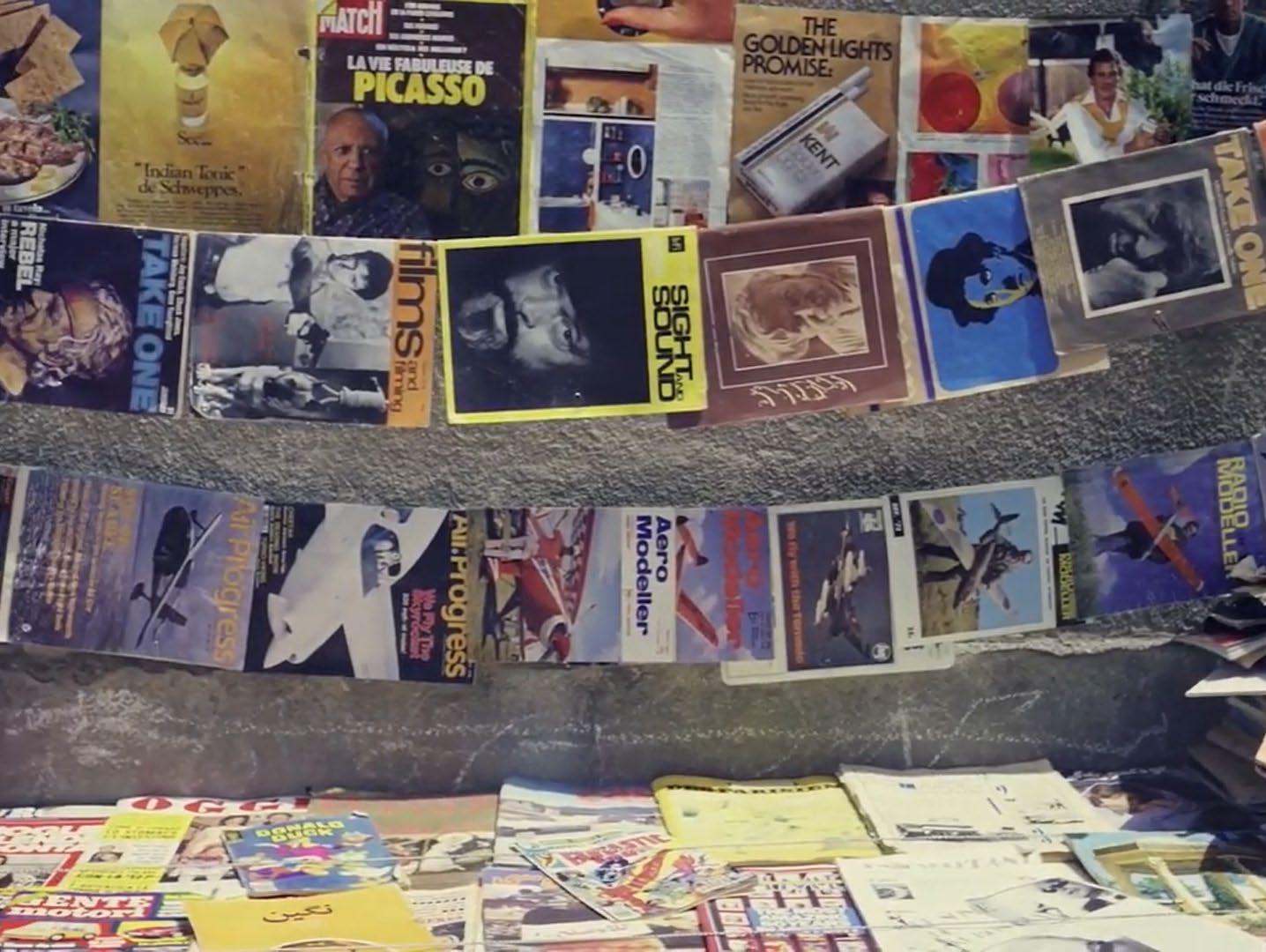
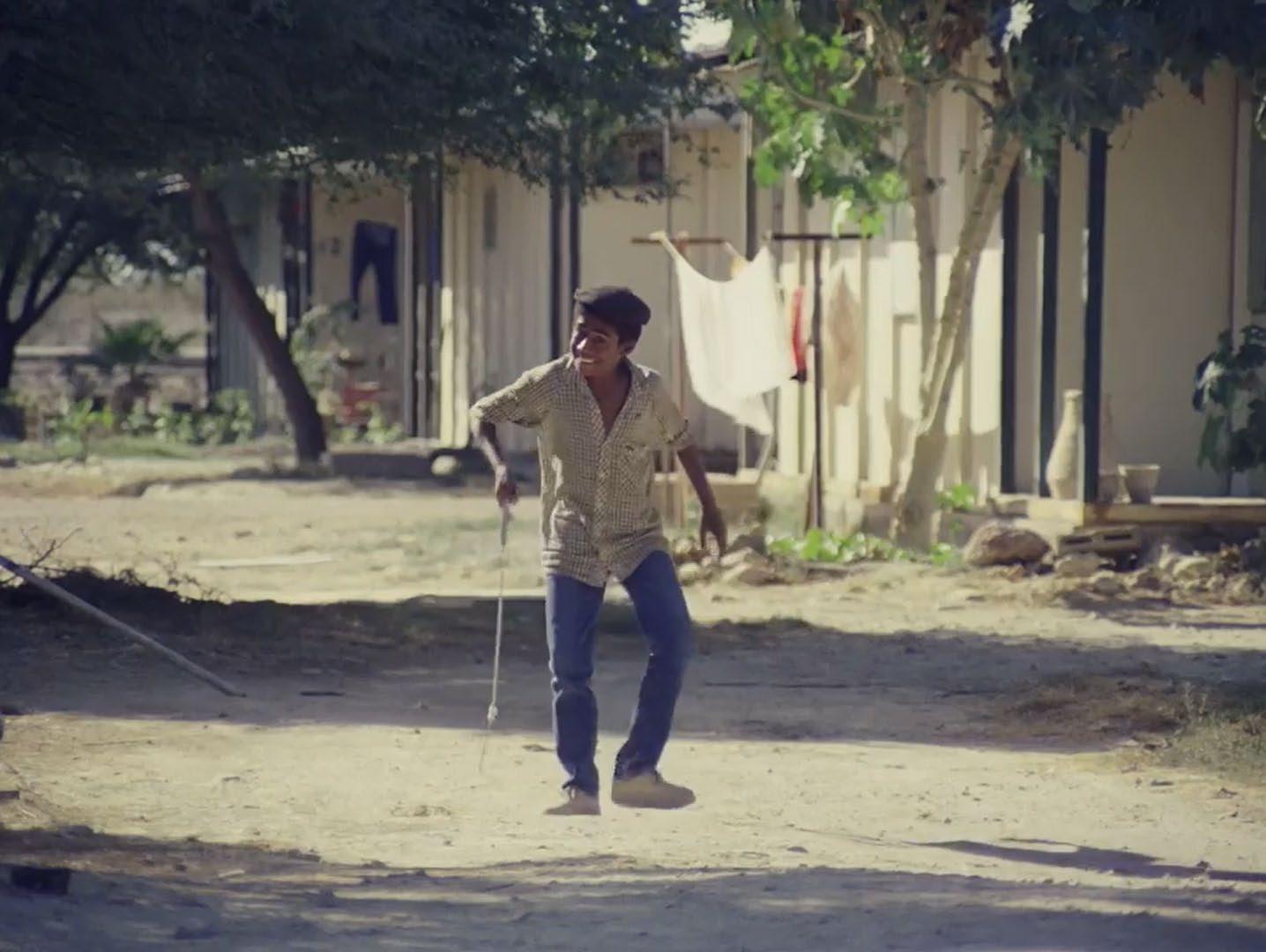

3 For more information on the plasticity of the body, please refer to Catherine Malabou’s
MISE - EN - SCÈNE 05 Amir Barati
The New Wounded (2007).
Fig. 3 | Magazines on a newsstand Amiro regularly visits in Naderi’s The Runner, 01:03:04. Center for the Intellectual Development of Children and Young Adults, 1984.
Fig. 4 | Mousa imitating Chaplin’s “tramp” walk in Naderi’s The Runner, 01:01:24. Center for the Intellectual Development of Children and Young Adults, 1984.
Fig. 5 | Children chasing a running train in Naderi’s The Runner, 00:43:03. Center for the Intellectual Development of Children and Young Adults, 1984.

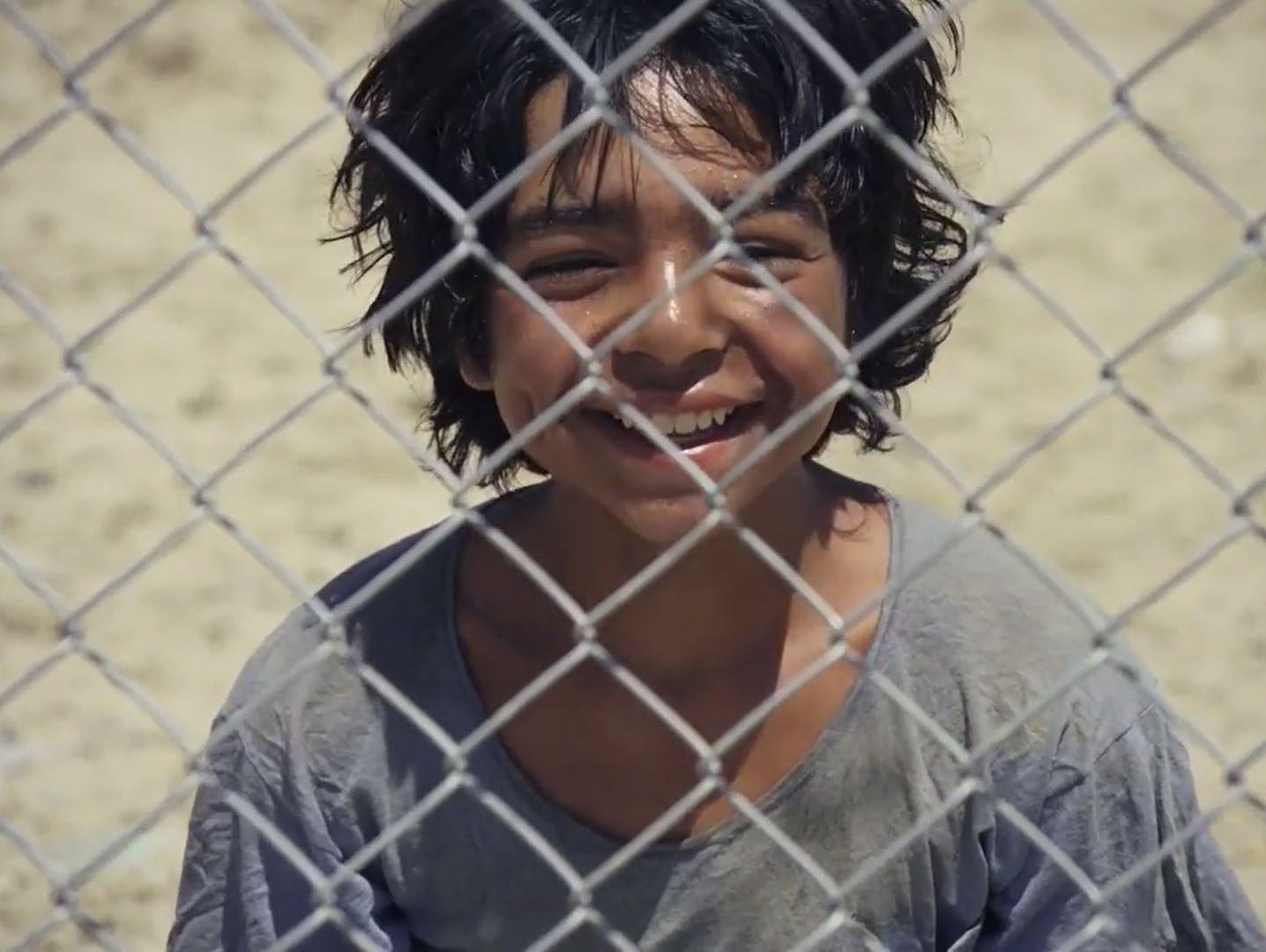
Naderi’s divergence from Chaplin is most evident in his representation of Amiro’s responses to the requirements of industrial city life. Unlike Chaplin, who was highly critical of modernity and blamed the machine age for the source of much misery in the industrial world, Naderi seems to have moved beyond this criticism to highlight the ways in which human beings master the discourse of the machine. In this respect, Naderi is mainly Lacanian rather than Chaplinian in that he directs his camera towards the human’s desire for the power produced by machinery and technological advancement. In Chaplin’s cinema, there exists only fascination with but no desire for the hustle and bustle of modern city life. For Chaplin, modernity was an endogenous development in Western society that the public was not ready for. Yet for Naderi, this modernity is borrowed and imported from the West—from the modern and advanced colonial Other—and therefore the imported machine causes its own fetishism as an object of desire. These two layers need further elaboration.
its destabilizing composition and absence of exposition, this sequence would convince viewers to consider Amiro as a castaway desperate for help (Fig. 6).
The dream-like atmosphere persists when Amiro is shown behind the fence looking at an aircraft (Fig. 7). Amiro’s joy represents his desire for machines as a way to fly away from the shores and borders of his present circumstances.
These sequences have urged many critics to interpret the film as an expression of Naderi’s longing to escape his restrictive space. But this scene is only the beginning of Amiro’s dramatic and intellectual journey.
The machine turns out to be a fetishized obsession in The Runner. Amiro loves machines. He visits his beloved airplane almost every day after work. He communicates with ships by shouting at them. He keeps pictures of airplanes in his home. While collecting recyclables among garbage piles, he sees a cruise ship passing and says, “How white! How beautiful!” (00:05:42). White is a desirable colour under the region’s scorching sun,
The fetishistic obsession with modern machinery can be located in the games and actions of the children in the film while they constantly walk among heavy machinery.
From the beginning of The Runner, Naderi formulates the idea of the desire for the machine. The film begins by showing a portrait of Amiro in loose-fitting underwear and breathing heavily while he stares into distance for 13 seconds. As birds sing in the background, he begins shouting and waving a piece of cloth in his hand. The establishing shot shows a barren lagoon and a mirage in the background. A large ship appears far away from the shore. Then, Amiro turns into a dream-like figure, running and shouting on the shore. With
and what he perceives as beauty in the advanced machinery. Amiro spends his free time sitting at the port watching the passing ships. He buys a broken lamp to illuminate his traumatic world. Electricity and lamps are technologies that Amiro loves to own.
Amiro even beckons the industrial noises. Gadassik provides an insightful perspective of sound in the film by noting that the most notable sounds come from machines: “In The Runner , most of the memorable sounds do not
Vol.07 No.01 | Spring 2022 06
The Runner : Trauma of Modernity and Desire for the Machine
Naderi’s
Fig. 6 | Amiro running and shouting on the shore in Naderi’s The Runner, 00:02:20. Center for the Intellectual Development of Children and Young Adults, 1984.
Fig. 7 | Amiro is happy when he finds images of airplanes in Naderi’s The Runner, 00:33:25. Center for the Intellectual Development of Children and Young Adults, 1984.
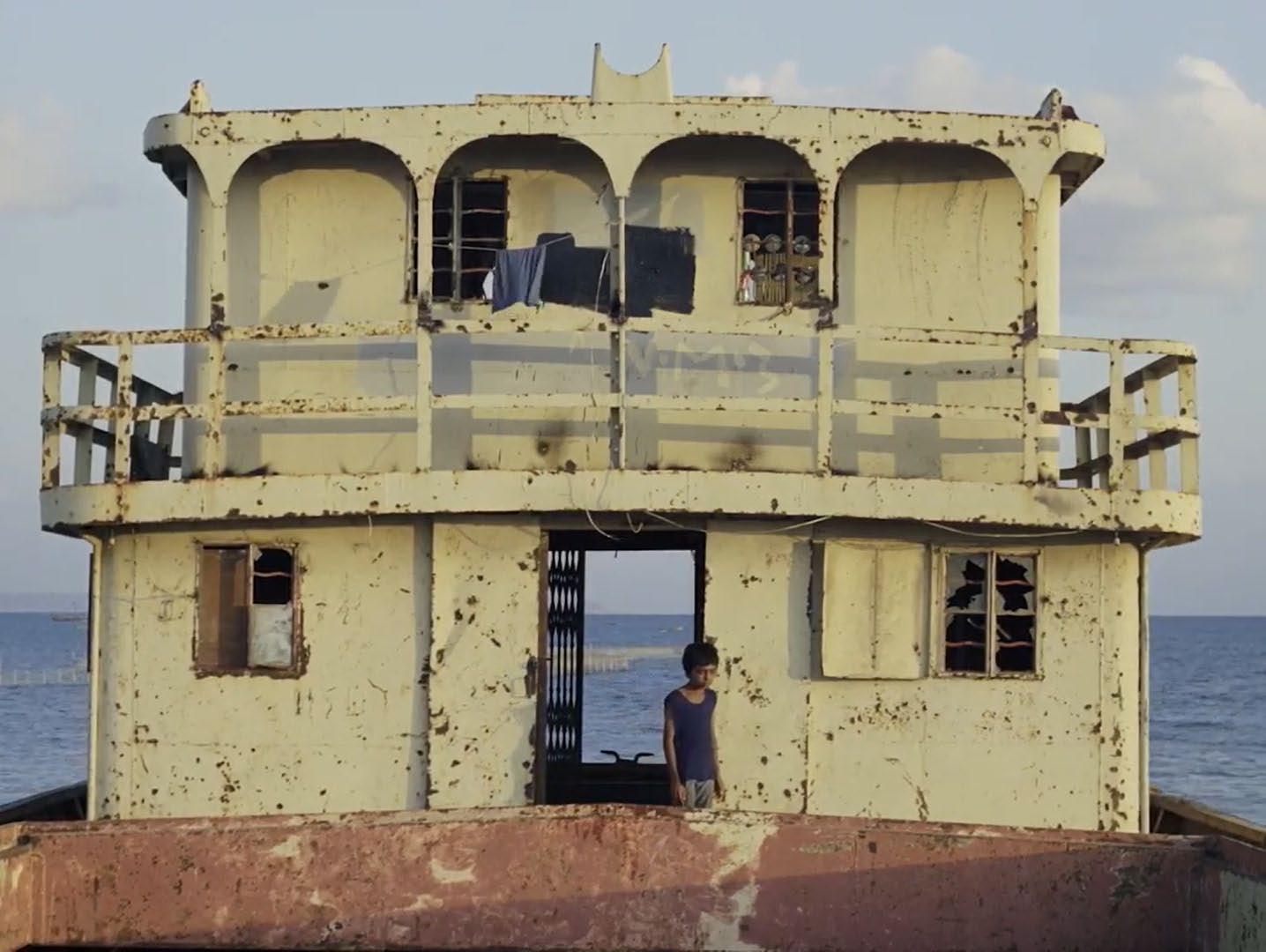
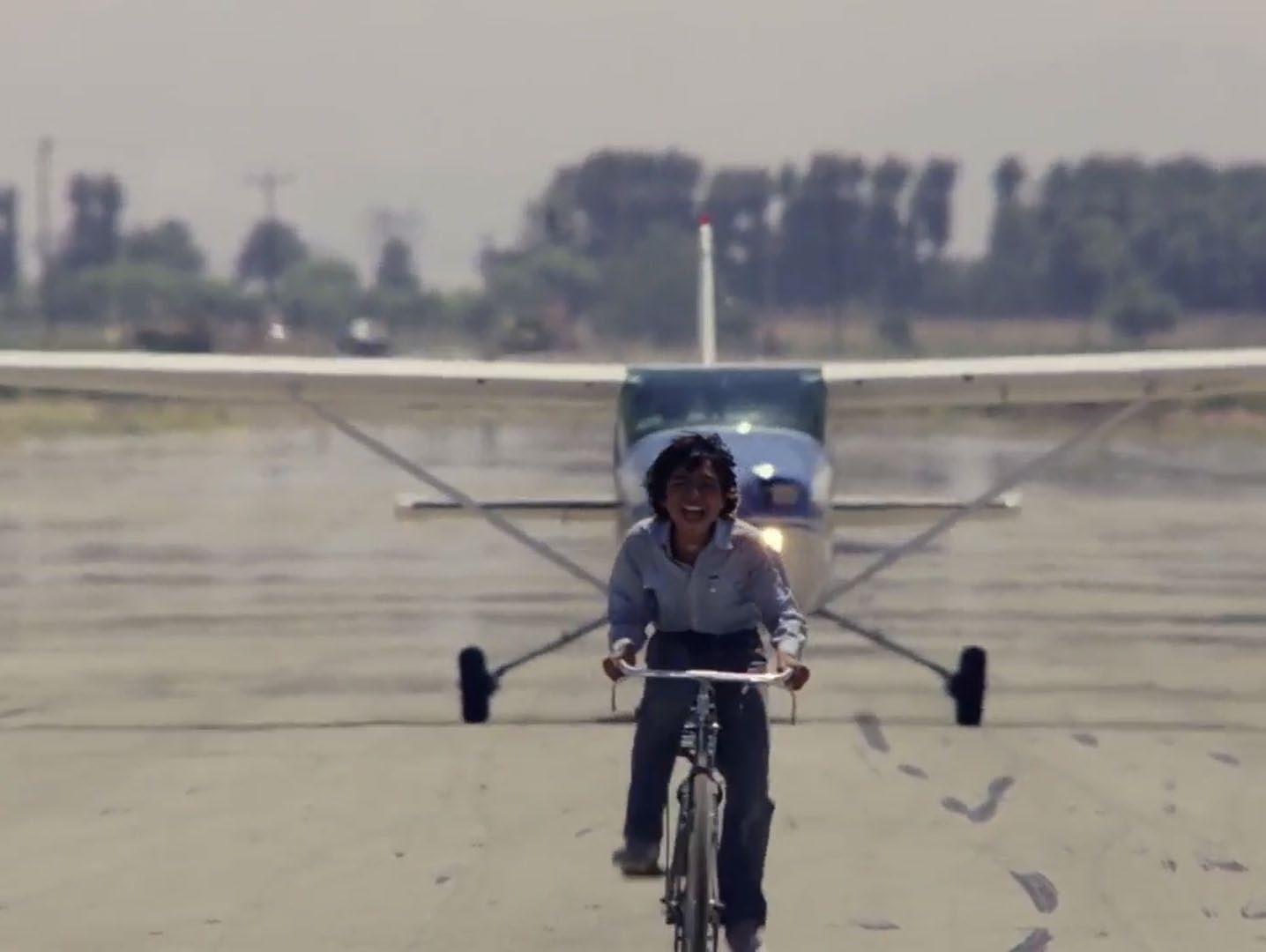
come from within the immediate location but drift in from the margins. Sounds of cars, trucks and trains surround the frame and plant the viewer into the city’s industrial zone much more firmly than the relatively sparse visuals” (485). Amiro craves the noises of engines and industries, demonstrating an obsession with the industrial machines and their extensions into human life.
The fetishistic obsession with modern machinery can be located in the games and actions of the children in the film while they constantly walk among heavy machinery. Amiro sees the power in modern machinery and yearns for it. This desire for the power of the machine is not for the destructive power or strength of mechanical power. This desire originates from the will to overcome the unjust daily struggle Amiro faces. In the machine, he perceives the power to transform his life into a more affluent, less hot (hence the prevalence of ice in the film), more docile, and in general, richer existence. Despite the intensity of his desire, Amiro is left within the jammed machine: a wrecked ship (Fig. 8).
Amiro lives a slumdweller’s life and the only difference he knows between his own misery and the pleasure of the Other is that he has access to the run-down machine while the Other drives the fast-moving operational machinery. Thus, automation occupies the diverging space between misery and pleasure for Amiro.
Moreover, because the machine is a Western product in this southern port, and all the industries are imported into the region, Naderi shows how this imported mechanization affects the human body in a society which is completely naïve about it. The discourse of the machine is completely alien to the young boys, yet they must live through its alien discourse. The power imbalance between the bearers of technology and the local population also leads to further suppression of the impoverished local population, though these bearers have the potential to bring about productive change. Amiro stands on this ambivalent
position—on the border between his unconscious desires and material condition—desiring media representations of modernity that promise peace, prosperity, and power, and all the while living through the purgatorial conditions that imported modernity has created for him.
Moreover, the film illustrates the naïve mindset of local children as they compete with the machine by using their own mechanized bodies. All the children’s competitions with machines are doomed to fail; thus, Amiro struggles to find a way out of this mentality. To navigate their situation, Amiro begins to test alternate ways to compete with modern machinery. His bike race with an airplane is the pivotal moment in which he begins to think outside the box. Using the bike, Amiro attempts to absorb the discourse of the machine by using a machine to compete with another one (Fig. 9).
To master this discourse, Amiro finds photos of airplanes in aviation magazines to educate himself about them. He signs up for school in an attempt to learn the language of the machine, using linguistic literacy as a first step in education instead of relying on the mere use of his body in an unfair competition. The movie parallels linguistic literacy as a first step that enables the practitioners to read and begin their apprenticeship with the discourse of the machine. His education helps him to read magazines and further learn the discourse of the Other instead of living through the imaginary world of desires displayed in flashy magazines, beautiful pictures, and powerful planes. For Amiro, learning the discourse of the Other is synonymous with apprenticing the discourse of the machine since the Other owns the machine. Amiro wishes to master this technological culture of advancement (which has resulted in the pleasure of the colonial forces) with the hope that he may enjoy similar power and dominance over his life and others.
With respect to modernity and the condition of humankind at this age, Lacan assumes that human subjectivity cannot be defined only through the formula of inner necessities, but
MISE - EN - SCÈNE 07 Amir Barati
Fig. 8 | The wrecked ship where Amiro lives in Naderi’s The Runner, 00:19:51. Center for the Intellectual Development of Children and Young Adults, 1984.
Fig. 9 | Amiro racing an airplane on a bike in Naderi’s The Runner, 01:05:04. Center for the Intellectual Development of Children and Young Adults, 1984.
that it should be defined based on the world from which it emerges. Material inventions including language, writing, machinery, clocks, and media form the subject, and extend their effects to the past because they become an inalienable part of human perception. Lacan opines that “the machine isn’t what a vain people think it is. It isn’t purely and simply the opposite of the living, the simulacrum of the living . . . . Pascal showed us that ‘the machine is tied to radically human functions’” (Seminar II 74). In a Lacanian manner, humanity’s functioning is contingent upon the way the machine age inscribes in us our subjective impulses. The same problem exists in The Runner. Having internalized the power of the machine as their object cause of desire, these machine-age children direct all their efforts to create the same mechanisms and automation in their bodies so as to match the speed, function, and power of the desired machine.
Among the machines, Amiro and the other children aim to recognize themselves and understand their own conditions. Thus, the only way to recognize themselves is either to define their subjectivity and agency in contrast to the desirable powerful machine or to recognize themselves through the social mirror of the Western seafarer whose lifestyle implies prosperity and happiness. As Lacan claims, “The subject is no one. It is decomposed, in pieces. And, it is jammed, sucked in by the image, the deceiving and unrealistic image, of the other, or equally by its own particular image. That is where it finds its unity” ( Seminar Book II 54). Accordingly, the children in the film
movements. The machine is liberating for Amiro because it has the power to move people beyond their bodily, geographical, and political boundaries and create new spaces free from corporeal limits.
Naderi’s film accords to theories of Lacan but addresses the specific historical trauma of Iran through a postcolonial lens that adds a significant dimension to Lacan’s discussion. The Runner shows how Western modernity colonizes an Iranian region’s socio-economic space and produces its own fetishistic desire in the Iranian collective mind. The power of the imported colonial machinery becomes the object cause of the desire for people who cannot access it but are governed by it. In this respect, the film’s “Ābādān is an exceptional laboratory for analyzing the contradictions caused by Iran’s economic development and industrialization” (De Planhol). Throughout the film, a sense of fragmentation and displacement causes viewers to constantly try to locate themselves in the scenes and composition, while most of these efforts will be doomed to fail. This sense of displacement is also a deliberate construct of the film to show the traumatic realities of modernity in traditional communities when, due to the special, historical, and symbolic ruptures that they encounter, people lose their position in the urban space. As Gadassik writes, “In addition to its uncertain temporal dimension, the film’s location is also fragmented and unclear” (477). This ambiguity—especially marked by the lack of establishing shots in the film—corresponds with the way the film portrays a fragmented space as a result of modernization and war.
Thus, with the help of Iranian director Bahram Beyzai as editor of The Runner, Naderi decided to cut the entire Iran-Iraq war out of his film … In light of such traumatic conditions, The Runner presents an allegorical representation of the psychosocial conditions that the war creates instead of showing the brutal realities of a war-torn society.
find their subjective presence through their encounters with machines, with the trains and airplanes as well as with the tradesmen and businessmen in the port. These encounters help them to perceive their identity and recognize themselves as supposed unified entities.
The magazine images that Amiro keeps might be ostentatious media, but, still, this American Dream-like object of desire helps him gather pieces of himself and project his unified identity in response to that imaginary world. In this way, Naderi best articulates the Lacanian assertions that “The symbolic world is the world of the machine” (Seminar Book II 47) and the “unconscious is the discourse of the other” (Seminar Book II 89). The Other for Amiro is the foreign tradesmen who disseminate the discourse of the machine. Therefore, Amiro’s unconscious desires are all captured in machines and their liberating
EFFACEMENT OF THE WAR MACHINES
Another aspect of modernity in The Runner which has been touched upon is the effect of the Iran-Iraq war (1980-88) on the film. Iranian war-time filmmakers have always attempted to capture the intensity of war scenes. However, the pain war creates is often absent because no representation can accurately capture that pain. Particularly, the severity of the experience of pain forbids any accurate and realistic representation to fully contain the suffering. Thus, with the help of Iranian director Bahram Beyzai as editor of The Runner, Naderi decided to cut the entire Iran-Iraq war out of his film.
Despite the presence of many indirect references, The Runner is deliberately stripped of all direct allusions to the war, which was ravaging most southern port cities of Iran at the time,
Vol.07 No.01 | Spring 2022 08
Naderi’s The Runner : Trauma of Modernity and Desire for the Machine

including Ābādān. The film was produced when many southern cities in Iran were ablaze from the Iran-Iraq war, but Naderi decided to hide the devastating events. Instead, he alluded to the consequences of wartime catastrophe. These images are remembrances of a history of modern damage inflicted upon the people of this region including displacements, poverty, the heavy presence of machinery, quarrels, fires of oil plants burning the skin, veterans with amputated legs, army jeeps on the roads, toxic air, and most important of all, the presence of children as traumatic subjects with specific social and psychological conditions. The use of fire and smoke along with the heat and heavy machinery is reminiscent of the war.
The Iraqi invasion of Iran in 1980 catalyzed one of bloodiest wars of the second half of the twentieth century due to its heavy use of imported modern artillery. This war—stretching to eight years of World War I-like trench warfare with approximately one million deaths on both sides—left the two countries with immense pain and devastation. The bombardments ravaged many southern cities of Iran, causing massive destruction and displacing scores in the Southern Khuzestan province where Amiro lives. In light of such traumatic conditions, The Runner presents an allegorical representation of the psychosocial conditions that the war creates instead of showing the brutal realities of a war-torn society. The film also contemplates how to deal with, confront, or escape this miserable space. The film also highlights the destructive force of the machine and the way this destructive part of the discourse is an integral aspect of it as well.
One of the key factors at play in minimizing the war was the film’s producing institute, the Center for the Intellectual Development of Children and Young Adults. The institute’s audience is predominantly children and young adults; consequently, there naturally comes the ethical responsibility to cut
out the violence of the war and aim for didacticism. Various references to the film can be directed toward the goals of omitting violence and being didactic, including the emphasis on the role of literacy in the development of children.4 For example, Amiro learns the Persian alphabet as a sign of his ultimate victory.
The effacement of the war could make the film unconsciously appealing to its young audience. In his Reflections on War and Death (1918), Sigmund Freud stresses that the human psyche has an “unmistakable tendency to put death aside, to eliminate it from life… to hush it up” (Reflections). Instead of portraying the brutalities of the war—an effort which always fails to fully represent the reality of death—Naderi decides to entirely eliminate direct war scenes and death from his film. All that remains from the war are its threats, ghosts, and traumatic aftermaths. It seems as if, for Naderi, the actual event does not exist due to its temporary nature, but the reality of war lives on through its aftermath and the ruptures it creates in the social fabric and memory of the people who survive it.
Here, a psychoanalytic conflict exists between the pleasure principle and the death drive: Amiro tries to seek pleasure in a traumatic society ruled by war and the forces of death. The harsh games played by The Runner’s children can also be analyzed in this sense. The boys, most of whom share Amiro’s living conditions, take part in dangerous games to rehearse and rediscover parts of themselves that have been lost to this traumatized society. The conflict over ice best reveals the nature of this competition as an existential battle of adhering to the objects of desire. As a game based on out-injuring the opponent, the defeated ones represent the dead, while the ones who desire the power of the machine can narrate the war as a victory for themselves. In such a situation, the desire for the power of the machine becomes an existential one driving the subject towards their survival (Fig. 10).
These children constantly attempt to resituate their existence amid a fragmented social fabric whose symbolic texture has been torn apart by repeated traumas. Overall, without overtly pointing out the true causes behind the problem, the concealment of war still constructs a narrative which reveals many consequences for war-time children. The film shows the misery tolerated by the protagonists in a more productive manner, calling the young audience to work through the despair and identify with the assiduousness and competitive aspirations of Amiro.
Amiro does not have the means to leave the wreckage of his own ship, but continues to struggle, hoping for a mental departure for a new space outside of his traumatic society. Amiro resides in the liminal space between the earth and the sea—in the ship—but the cause of his loneliness—his orphaning—and how he chose the wrecked ship as his shelter are never revealed. The key to this condition can be found in Beyzai’s Bashu: The
4 Similar trends involving the minimization of war were applied to other Iranian visual art forms. For more information, refer to “The Notion of Comics in Iran” by A. Ghaderi and E. Esfandi (2015).
MISE - EN - SCÈNE 09 Amir Barati
Fig. 10 | Amiro wins the ice in a competition in Naderi’s The Runner, 01:26:56. Center for the Intellectual Development of Children and Young Adults, 1984.

Little Stranger: its protagonist manages to leave his southern city behind and find peace in the north (Fig. 11).
Set in Iran in the midst of the country’s war with Iraq, Bashu recounts the story of a young boy named Bashu (Adnan Afravian), who escapes the war-torn Khuzestan province in southern Iran by taking refuge on the back of a cargo truck. Not knowing the truck’s destination, Bashu finds himself delivered to the ever-green and peaceful Caspian region in the rural north of the country, where there seems to be no sign of war. But as a traumatized character, Basha remains haunted by the consequences of war and his displacement. Bashu successfully sails away from the shores of the war zone, while Amiro stays in the wreckage of his ship. This choice to leave one’s home city or stay in its ruins is a conflict that haunts Amiro, but, apparently, he chooses to live within his city, directing his desire towards winning games and thereby representing his struggle to succeed in life. Bashu’s family has been killed during a bombardment, while Amiro’s family has disappeared from the film with no clues as to their whereabouts. The stray condition of Amiro suggests a traumatic past, with his family lost at an unknown time. Take, for example, the scene where Amiro looks at himself aboard his wrecked ship. His distorted image is portrayed in a triangular piece of mirror while he shows embarrassment. The shame stems from his failure to confront belligerent
children while collecting bottles at sea, and the subsequent reprimands of Amoo Gholam (Abbas Nazeri) who reproached Amiro for lacking the strength to defend himself against other children.
The broken mirror symbolizes the distorted image Amiro possesses of himself because of the social pressures he has faced. The mirror represents a broken Amiro, not because of failing at a competition, but because of a life moulded by broken social structures. The Lacanian mirror which should reflect a unified image of the self is broken, and therefore, he struggles to find his true subjective self through media images and magazines (Fig. 12).
Amiro never talks about his past or narrates his trauma; instead, he attempts to hide the central reasons behind his miseries, much like Naderi’s obscuring of war in the film. If Amiro had a family to support him, he might not have to work so hard to feed himself. He could have gone to school much earlier and would not have to tolerate being a social outcast. Consequently, he would have experienced a much more forgiving life. But the cause itself is absent. No social institution is there to support him against the unjust competition for survival, and few people show him mercy. This is most likely the result of a military confrontation that has shred the already traumatic social fabric of Amiro’s homeland.
This situation suggests the Freudian lack of transference when the subject cannot move away from its resistances, ultimately disabling it from verbally communicating their psychological struggles. When language lacks the proper power to describe an abundance of trauma and the subject cannot communicate its wounds, the subject appeases itself through bodily expressions of shouting and running. So, the competitions are repeated in different, unending forms. This repetition of fierce rivalry, in which being hit by a train or breaking a limb is possible, reveals one aspect of the lack of transference in a traumatized society. Shouting to airplanes and competing by tolerating the noise of the close-passing trains are signs revealing the veracity of traumatic experiences like war planes bombing civilians.
Explaining this mental process, trauma theorist Geoffrey Hartman writes, “Life seems always to be a matter of catching up, often unconsciously… Something in the present, therefore, may resemble (or reassemble) something forgotten, as if there were channels along which memory returns like a flood that hides its source. This is where uncanny sensations of repetition or correspondence make themselves felt” (546). The history in this film is effaced and reassembled through the events and games the children play. In this situation, as Dominique LaCapra also notes, one acts out past experiences when one’s relation to the present collapses. In such a condition, the temporality of experience is lost, and every current or past traumatic experience and rehearsals happens in the moment while facing fragments of the past. The only temporal aspects that are distinct from the present are the “future possibilities” that lie ahead of the traumatic subjects (699). That is exactly why, for Amiro,
Vol.07 No.01 | Spring 2022 10 Naderi’s The Runner : Trauma of Modernity and Desire for the Machine
Fig. 11 | Poster of Beyzai’s Bashu: The Little Stranger. Center for the Intellectual Development of Children and Young Adults, 1986.

there exists no past and everything happens in the present. His only hope is for a future in which he sails away from his current mental and social condition and finds a better world. However, he remains stuck living in the wreckage of the past and is not sure whether he can steer his vessel.
fact. It tries to make us believe the unbelievable; it demands the acknowledgement of being real, not only imagined” (541). Amiro attempts to embody his desires and victories in the competitions with other children. This imagination needs a factual atmosphere as well and thus, the airplane and the
Naderi is aware that modernity is a time of global engagement and that is why his hero Amir-o (Amir Naderi plus Hero) suggests a progressive protagonist who wishes to keep his independence while fully engaging with Others.
The only real power Amiro has at his disposal while living in war is to utilize his imagination and live in a world of his own constructed symbolism. When the social structure is fragmented and in no way fulfilling, Amiro recreates his own symbolic version of the world around him in order to operate. Regarding the structure of imagination, Hartman believes that “Imagination pursues a body—the body and atmosphere of
machine can be considered incarnations of the mechanistic atmosphere that embody his desires. Amiro joins others but follows his own dreams. He is not a total outcast, but his independence helps him operate better than others and thereby mature. He constantly pursues improvement and is a desired body in the traumatic modern world of Iran. He strives not to give into his traumas and wills to fight for escape.
MISE - EN - SCÈNE 11 Amir Barati
Fig. 12 | Amiro looking at the mirror in Naderi’s The Runner, 00:18:54. Center for the Intellectual Development of Children and Young Adults, 1984.
CONCLUSION
The Runner ultimately reveals the story of a community traumatized by modernity. This community views the charming face of modernity in the comfort and power produced by machines, yet this community lives in the shadows of the same machines. The modern machinery left bombs instead of prosperity. This condition—as well as the witnessing of the Other’s prosperity—coerces Amiro (as the symbolic hero of the film) and other children to use their bodies to compete with the machine, challenge its power, and instruct their bodies to operate like the machine, too. However, Amiro takes a different route to utilize machines to his own benefit by riding his bike. Riding a bike as a materialist symbol of early machinery versus a more sophisticated airplane best represents the condition of Iranians of the time: on the verge of modernization yet gripped by a devastating war.
While this traumatic society sees its “characters [finding] themselves oscillating between productive determination and destructive obsession” (Gadassik 480), the film does not wholly support the binary oppositions between the Orient and the Occident or the human and the machine. Naderi is aware that modernity is a time of global engagement and that is why his hero Amir-o (Amir Naderi plus Hero) suggests a progressive protagonist who wishes to keep his independence while fully engaging with Others. He protects his own desires, does not imitate other children, and knows that his desires are the desires (and tensions) of many other children of his time. So, rather than drawing borders and oppositional lines, he decides to educate himself to learn the discourse of the machine which has secured the Others their power and leisure. His competition turns out to be a successful one when he manages to read the full Persian Alphabet (in a region where the majority speak Arabic with southern Iranian accents) against the roaring engines of sophisticated airplanes.
While being sympathetic to the miseries of children in south Iran, Naderi propagates a politics of perseverance and goal-oriented diligence. He advocates for literacy and systematic education as a panacea to overcome the miserable conditions for children in a developing country in the 70s. But the key to his quest is finding a way to streamline the local literacy in order to provide the requirements for comprehending the discourse of modernity. He desperately attempts to represent a materialist approach where, through utmost diligence, local literacy can live side-by-side with modern machinery—it is a significant symbol of an imported modern discourse. This optimistic quest for synchronization of parallel ways of being (traditional and modern lifestyles) has made The Runner a unique product of Middle Eastern cinema. The idea that children of the machine age need to learn the discourse of the Other and the machine to adjust their local lives with this ontology is of unparalleled significance since it represented the mindset rampant in the 70s and 80s; it resulted in highly educated youths in Iran today. Yet Naderi’s hopes and dreams did not come true. The gulf between Western modernity and the traditional values of the local Middle
Eastern population has widened in the past decades and created innumerable tragedies in many Middle Eastern countries and the Islamic World.
Naderi also portrays the go-getter, semi-capitalist politics of rivalry which caused immense problems in Iranian society for years to come. The idea that the comfort of reaching the ice (as a sweet product of modern machinery) should be the aim of every child in a modernizing country proved problematic. During the 70s, the politics of fierce competition for personal gain at the cost of Others overwhelmed the traditional Iranian society which was mainly based on communitarian values. Despite the inevitability of rat-race social practices in modern cities, this mindset of the supremacy of personal gain introduced to Iranian society deep complications including brutal individuation, devalued ethical norms, economic corruption, and many more cultural, political, and economic conflicts that were not compatible with older communitarian systems of Iranian ethnic communities. Many years later, politics of social justice and equality replaced this outlook in Iranian cinema.
Vol.07 No.01 | Spring 2022 12
the
Naderi’s
The Runner : Trauma of Modernity and Desire for
Machine
Amanat, Abbas. Iran: A Modern History. Yale UP, 2019. Barati, Amir, and Razieh Eslamieh. “Ian McEwan’s Characters in Žižekian Process of Subjectivity A Study of Ian McEwan’s Atonement and Solar.” International Journal of Applied Linguistics and English Literature, vol. 4, no. 2, 2015, pp. 120-124, doi.org/10.7575/aiac.ijalel.v.4n.2p.120 . Accessed 2 Jan. 2022.
Bashu, the Little Stranger. Directed by Bahram Bayzai, performances by Firooz Malekzadeh, Susan Taslimi, Parvis Pourhosseini, and Farokh-Lagha Hushmand, Center for the Intellectual Development of Children and Young Adults, 1986.
Braves of Tangestan . Directed by Homayoun Shahnavaz. Performance by Mahmoud Johari, Shahrouz Ramtin, Kaveh Mokhberi, and Ali Akbar Mahdavifar. Iranian National Television, 1975.
De Planhol, X. “ĀBĀDĀN ii. Modern Ābādān,” Encyclopaedia Iranica, vol. 1, no. 1, 1982, pp. 53-57, www.iranicaonline. org/articles/Ābādān-02-modern. Accessed 03 May 2016.
Freud, Sigmund. Beyond the Pleasure Principle, edited by Ernest Jones, International Psychoanalytic Library, 1922.
---. Reflections on War and Death. Translated by A. A. Brill and Alfred B. Kuttner, Moffat, Yard and Co., 1918.
Gadassik, Alla. “A National Filmmaker without a Home: Home and Displacement in the Films of Amir Naderi.” Comparative Studies of South Asia, Africa and the Middle East, vol. 31, no. 2, 2011, pp. 474–486, doi-org. proxy.library.umkc.edu/10.1215/1089201X-1264361
Accessed 2 Jan. 2022.
Ghaderi, A., and E. Esfandi. “The Notion of Comics in Iran.” Comics: Bilder, Stories und Sequenzen in religiösen Deutungskulturen. Kulturelle Figurationen: Artefakte, Praktiken, Fiktionen, edited by J. Ahrens, F. Brinkmann, and N. Riemer, Springer VS, 2015, pp. 204-233, doi. org/10.1007/978-3-658-01428-5_9. Accessed 2 Jan. 2022.
Gunning, Tom. “Chaplin and the body of modernity.” Early Popular Visual Culture, vol. 8, no. 3, 2010, pp. 237-245, doi.org/10.1080/17460654.2010.498161. Accessed 2 Jan. 2022.
Hartman, Geoffrey H. “On Traumatic Knowledge and Literary Studies.” New Literary History, vol. 26 no. 3, 1995, p. 537-563. Project MUSE, doi:10.1353/nlh.1995.0043. Accessed 2 Jan 2022
Kittler, Friedrich A., and John Johnston. Literature, Media, Information Systems: Essays. Routledge, 2012.
Lacan, Jacques. The Seminar of Jacques Lacan: Book II. Translated by Sylvana Tomaselli, edited by Jacques-Alain Miller, Norton, 2011.
---. The Seminar of Jacques Lacan: The Four Fundamental Concepts of Psychoanalysis (Book XI). Translated by Alan Sheridan, edited by Jacques-Alain Miller, Norton, 1998.
LaCapra, Dominick. “Trauma, Absence, Loss.” Critical Inquiry, vol. 25, no. 4, 1999, pp. 696–727. proxy.library.umkc. edu/login?url=http://search.ebscohost.com/login.aspx?direct=true&db=mzh&AN=0000315474&site=eds-live&scope=site. Accessed 2 Jan 2022.
Malabou, Catherine. The New Wounded: From Neurosis to Brain Damage. 1st ed, Fordham UP, 2012.
Motaqedi, Robabeh, et al. “Oil Industry and Development of Population and Occupation in Oil Rich Regions in the South of Iran.” Researches on Social History, vol. 3, no. 2, 2014, pp. 121-137. search.ebscohost.com/login.aspx?direct=true&db=edsdoj&AN=edsdoj.0367be6200714620b6fe90b25d7d2ed5&site=eds-live&scope=site. Accessed 2 Jan. 2022.
Naficy, Hamid. A Social History of Iranian Cinema. Duke UP, 2011.
The Runner. Directed by Amir Naderi, performances by Abbas Nazeri, Majid Niroumand, and Musa Torkizadeh. Center for the Intellectual Development of Children and Young Adults, 1984.
Tangstir. Directed by Amir Naderi, performances by S. Chubak, Nemat Haghighi, Enayat Bakhshi, Parviz Fanizadeh, Jafar Vali, and Behrouz Vossoughi. Ali Abbasi, 1973.
Zeydabadi-Nejad, S. “Iranian Intellectuals and Contact with the West: The Case of Iranian Cinema.” British Journal of Middle Eastern Studies, vol. 34, no. 3, 2007, pp. 375–398. www.jstor.org/stable/20455536. Accessed 2 Jan. 2022.
MISE - EN - SCÈNE 13 Amir Barati
WORKS CITED
The End of Everything
Millennium Anxiety in Gregg Araki’s Nowhere
BY HENRIQUE BRAZÃO Independent Film Scholar
ABSTRACT
With its idiosyncratic cinematic language, Nowhere (1997), directed by indepedent American filmmaker Gregg Araki, notably conveys a sense of acceleration and anxiety associated with the impending turn of the millennium. One of the film’s many fast-paced sketches—showing a young couple ending their relationship—serves as a corollary of a doomed generation caught in the vortex of rampant technological development in an era of excess and disposable emotions. Through sound, framing, and editing—and involved in the context of Y2K concern and Christian eschatology—Araki creates a universe where nothing is permanent, where everything ends.
Gregg Araki’s film Nowhere (1997) pulsates with the energy of transgression. Like its predecessors, this chaotic example of independent cinema reveals a profound conscience of cinematic conventions while simultaneously rebelling against those formalities. A particular scene—showing two characters ending their tumultuous relationship—highlights the concept of “millennium anxiety,” a much-discussed (and somewhat abstract) notion imbued in media and cultural conversation throughout the 1990s, connoting a collective sense of uncertainty about the symbolic arrival of the third millennium.1
Nowhere is the final piece of a trilogy known as “the teenage apocalypse trilogy” (Hart 33) and arguably the most apocalyptic manifestation of the group. The film displays a mosaic narrative with an ensemble cast, featuring the protagonist Dark (James Duvall), an eighteen-year-old college student who believes his death is impending. Many young characters with one-word nicknames like Egg (Sarah Lassez), Lucifer (Kathleen Robertson), Mel (Rachel True), Zero (Joshua Gibran
Mayweather) or Ducky (Scott Caan), populate this frenetic and hyper-saturated universe. Set in Los Angeles during a single day, Araki’s film does not present a discernible classical narrative arc, favoring chaos and fragmentation over causality. Throughout the day, the connections between the parts are established through fast-paced sketches—almost all of them invariably flooded with diegetic music— that show the characters’ interactions while addressing a torrent of issues, such as sexual awakening and orientation, relationship boundaries, eating disorders, drug abuse, religious fanaticism, celebrity culture, existentialism and, ultimately, the end of the world. A party held during the evening becomes the convergence point where all the subcultures collide, and where fragile egos—underdeveloped teenage personalities struggling for affirmation—break. Through the deaths of two characters and the alien abduction of a few others, the film conveys a melancholy theme of impermanence in an erratic time and place, thereby producing a bleak portrait of a (doomed) generation that cannot help but accept the end of everything. The ending that these
1 The term “anxiety” is loosely employed here, considering its colloquial expression rather than its strict medical definition.
Vol.07 No.01 | Spring 2022 14
FEATURETTE

(purposefully) one-dimensional characters collectively experience coincides with the end of the century, mainly defined by abrupt technological changes and the apprehension over the Y2K phenomenon.2
Despite the film’s coherent sense of aesthetic identity, the scene in question is detached from the main narrative because of its unique traits (Fig. 1). Most notably, the formerly omnipresent music is replaced by remote, indistinct traffic sounds, and the sardonic tone of the dialogue is suspended, making way for vulnerability and introspection to emerge.
Running slightly over one minute, the scene consists of four different camera positions, resulting in twenty-one editing shots. The shot/reverse shot dialogue is enclosed between two establishing shots, with opposite tracking movements, and there is an isolated insert of a dirty hand. This conventional approach to scene construction, a strong legacy of Classical Hollywood, is subverted by the number of cuts—it is closer to music video standards than that of narrative cinema— where the accelerated rhythm underscores the substance abuse subtext. The action is minimal: Cowboy (Guillermo Diaz) arrives at what is possibly the fringes of a highway, where his heroin-addicted boyfriend Bart (Jeremy Jordan) lies, after injecting himself. Cowboy wants to make an ultimatum. The
low angle long-shot that opens the scene shows the silhouettes of the characters against a bright purple sky. Bart rests on a metal structure from the back of a hotel advertisement, where a neon heart and the word “rooms” can be seen. The framing gives the impression that the tip of the heart-shaped sign rests right above Bart’s chest. Colourful yet unclean, the shot contrasts the visual noise of the metal girders and the tranquility of the chromatic scheme, particularly the violettinted sky. This idealized, abstract portion of the city echoes the film’s off-screen opening line, spoken by Dark: “LA is like, nowhere. Everybody who lives here is lost” (00:00:15-00:00:18).
Nowhere’s Los Angeles is an amalgam of colours and textures with few (if any) recognizable locations. It is an assembly of non-places (Augé 76), and the characters are as lost and disjointed as the spaces around them.3
A visibly concerned Cowboy (Fig. 2) confronts his boyfriend and tells him he can no longer deal with his addiction. The dynamics of the dialogue are established by the camera angles and framing. Cowboy, disappointed and mournful, appears smaller and therefore powerless, while Bart is seen from Cowboy’s point of view, on an unsettlingly tight close-up, with his head upside down (Fig. 3). After hearing his lover’s threat, Bart, whose reactions are manifestly slow and apathetic,
2 The Y2K problem, or “the year 2000 bug,” was a widely held concern that, at the end of 1999, computers would not be able to compute the abbreviation 00 in 2000 and would cause a massive collapse in information systems around the world. Except for a few minor occurrences, the transition was uneventful (Tapia 267).
3 The concept of non-place, as defined by French professor of anthropology and ethnology Marc Augé, considers technological development and globalization to produce a discourse about the relations individuals establish with the proliferation of modern transient areas, like highways, shopping malls, or airports (Augé 76).
MISE - EN - SCÈNE 15 Henrique Brazão
Fig. 1 | Still from the opening scene of Araki's Nowhere, 00:24:17. UGC, 1997.
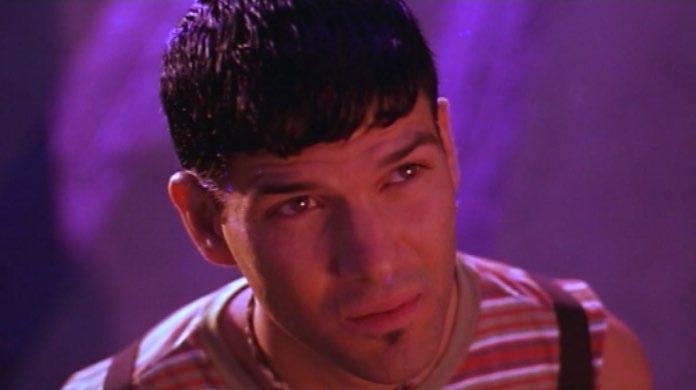

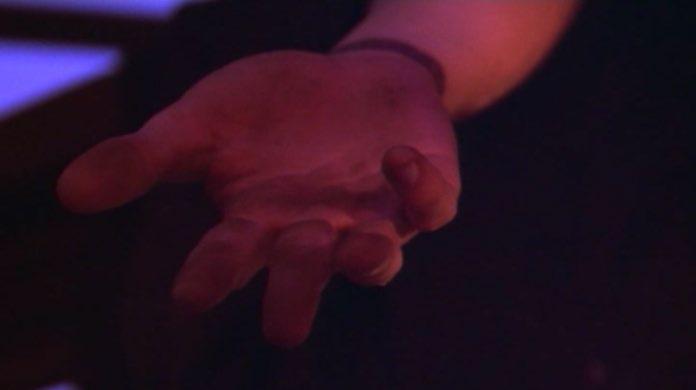
makes a vague promise to get sober and extends an unkempt hand (Fig. 4). Cowboy ignores the gesture and leaves the scene. In a film with a considerable amount of close-ups, the dirty hand consolidates an aesthetic strategy that reveals the tactile dimension of the moving image.4 In various scenes, the protagonist uses a video camera that produces grainy, low-resolution pictures (Figs. 5 and 6) that entail haptic visuality qualities (Marks, Touch 3). Here, the brief insert of the hand—a direct reference to the haptic—not only alludes to the possibilities of
film as a multi-sensory medium but also invigorates the narrative: Bart’s gesture is a cry for help, or a thin vestige of love wherein the dirt straightforwardly describes the character’s deplorable circumstances.
As the micro-romantic tragedy unfolds, the film—whose prevalent nonverbal discourse is filtered here through Cowboy’s perspective—makes a moral statement against excess. Isolated and geometrically confined between strict lines, Bart embodies the consequences of succumbing to a lifestyle of continuous self-destruction. For less than three seconds, the wistful image of his abandoned body pauses the turbulence of the plot. Apart from this small glimpse, there is no time for contemplation in Nowhere. Static moments are rapidly consumed by the film’s voracious pace, leaving the spectator longing for breathing space.
A state of anxiety affects the film’s diegetic world as much as the viewer. As previously inferred, the editing, mise-en-scène choices, and the actors’ crude performances contribute to the construction of a meaning that is symptomatic of the cultural and social context surrounding the production and release of the film as a cultural object (Bordwell and Thompson 62-63). Focusing on the examined scene and its bizarre aftermath—Bart commits suicide after being encouraged by a televangelist—the degradation of life caused by external forces (drugs, television, urban geography, alienation) mirrors the general attitude and anxieties regarding the anticipation of the year 2000. The religious undertones related to the fates of these young people directly evoke Christian eschatological discourses and the numerical and chronological importance of the arrival of the third millennium (Tapia 269). Scholarly discussion about this symbolic transition tends to address a “felt condition that unsettled a naturalized sense of temporal and historical progression” (Balanzategui 68), or, as put forward by Jean Baudrillard, the idea of the year 2000 was even associated with “terror” (9). With his provocative trilogy—especially with its conclusion—Araki has delivered a peculiar portrait of unsettling times, best observed two decades later, with the privilege that time allows.
If the nihilistic approach to the inevitability of death defines the ethos of Nowhere, a more concerned (and openly pessimistic) mindset related to millennial distress surfaces sporadically. Bart and Cowboy’s moment—with its minimal dialogue, the asymmetry of the characters’ positions, the messy advertisement-like surroundings, the frantic succession of shots, and the overall troubled mood—epitomizes this atmosphere of apprehension and, along with many other instances, makes Nowhere a product of its time, a memento mori for the twentieth century.
4 As studied by authors like Canadian film and media theorist Laura U. Marks, the moving image is capable of generating sensory responses beyond sight and sound. For the author, touch or smell are effectively stimulated by audiovisual content (Marks, The Skin of the Film 2).
Vol.07 No.01 | Spring 2022 16 The End of Everything: Millennium Anxiety in Gregg Araki’s Nowhere
Fig. 3 | Low-angle shot of Bart from Araki’s Nowhere, 00:24:33. UGC, 1997.
Fig. 4 | Bart extends his dirty hand in Araki’s Nowhere, 00:24:50. UGC, 1997.
Fig. 2 | Cowboy confronts Bart from Araki’s Nowhere, 00:24:21. UGC, 1997.

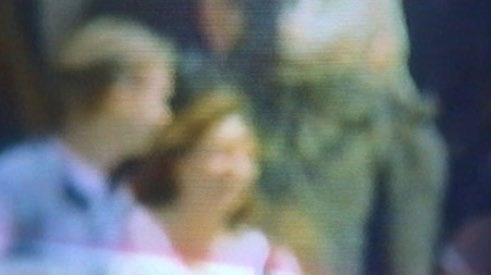
WORKS CITED
Augé, Marc. Non-Places: An Introduction to Supermodernity . Translated by John Howe, Verso, 2008.
Balanzategui, Jessica. “The Uncanny Child of the Millennial Turn.” The Uncanny Child in Transnational Cinema: Ghosts of Futurity at the Turn of the Twenty-First Century, Amsterdam UP, 2018, pp. 67-92, doi.org/10.2307/j. ctv80cc7v.6. Accessed 15 Dec. 2021.
Baudrillard, Jean. “Pataphysics of the Year 2000.” The Illusion of the End. Translated by Chris Turner, Polity Press, 1994, pp. 1-9.
Bordwell, David, and Kristin Thompson. “The Significance of Film Form.” Film Art: An Introduction, 8th ed., McGrawHill, 2008, pp. 53-73.
Hart, Kylo-Patrick R. Images for a Generation Doomed: The Films and Career of Gregg Araki. Lexington Books, 2010.
Marks, Laura U. “Introduction.” The Skin of the Film: Intercultural Cinema, Embodiment and the Senses, Duke UP, 2000, pp. 1-23.
---. “Video Haptics and Erotics.” Touch: Sensuous Theory and Multisensory Media, Minnesota UP, 2002, pp. 1-20.
Nowhere. Directed by Gregg Araki, UGC, 1997.
Tapia, Andrea Hoplight. “Techno-Armageddon: The Millennial Christian Response to Y2K.” Review of Religious Research, vol. 43, no. 3, 2002, pp. 266-86, doi. org/10.2307/3512332. Accessed 16 Dec. 2021.
MISE - EN - SCÈNE 17 Henrique Brazão
Fig. 5 | A detail from Dark’s camera—Montgomery (Nathan Bexton)—in Araki’s Nowhere, 00:08:28. UGC, 1997.
Fig. 6 | A detail from Dark’s camera—the alien—in Araki’s Nowhere, 00:08:28. UGC, 1997.
Same Women, Altered Autonomy
A Close Look at the Perception of Power in Carol
BY ALEXANDRIA JENNINGS Youngstown State University
ABSTRACT
This essay illuminates the delicate power dynamic that is present between Carol Aird (Cate Blanchett) and Therese Belevit (Rooney Mara) in the film, Carol (Todd Haynes, 2015), and argues that there is one integral repeated scene that represents a major shift in the characters’ individual autonomies. The emblematic scene is deconstructed to illustrate that both the transformation of character and the viewers’ perception of the characters’ autonomies in the repeated scene are necessary antecedents to the outcome of the film. Close analysis of each iteration of the scene’s mise-en-scène paves way for the distinct character shifts that ultimately lead to a dual metamorphosis between both protagonists in the midst of a complicated queer story.
Carol (Todd Haynes, 2015) is largely based on Patricia Highsmith’s 1952 novel, The Price of Salt , and it offers a glimpse into the complicated relationship of conflicted housewife, Carol Aird (Cate Blanchett), and twenty-something seasonal retail worker and aspiring photographer, Therese Belevit (Rooney Mara). In this article, I identify the power dynamic between Carol and Therese and illustrate the major character transformations that take place during the film. Both their metamorphoses can be identified through close mise-en-scène analysis, specifically in the film’s two restaurant scenes. The first scene is from Therese’s point of view, and the second from Carol’s. Through slight alteration of camera angle and reframing, their alternate perspectives are offered. I suggest this scene was repeated because director Todd Haynes wanted to amplify the drastic shifts in the characters’ individual autonomies to represent the duel awakening that occurred. In the second iteration of the scene, the viewer’s perception of both Carol and Therese is drastically altered. The shots from the analyzed scenes occur inside a restaurant where Carol and Therese sit together at a table.
Before understanding how both Carol’s and Therese’s individual autonomies undergo substantial changes, the characters’

initial characteristics must be examined. In the beginning of the film before the dual metamorphosis occurs, Haynes portrays Carol as wealthy, confident, charismatic, and dominant through her luxurious wardrobe and commanding red lip (Fig. 1). She is
Vol.07 No.01 | Spring 2022 18
FEATURETTE
Fig. 1 | Carol’s costume demonstrates her wealth and power, Carol, 00:20:43. The Weinstein Company, 2015.
sure of each decision she makes. Even her home symbolizes class and opulence (Fig. 2). On the other hand, Therese is the antithesis of Carol. Therese is younger, working class, underwhelmingly dressed, and indecisive, mimicking a leaf traveling in whichever direction the wind takes it. Haynes portrays these characteristics through her plain wardrobe and her dependency on Carol. She is indifferent in her relationship with her boyfriend, Richard (Jake Lacy), and cannot make a conclusive decision about anything in her life. She often needs guidance like a child would, and it is not until Therese’s transformation that she sheds her child-like attributes.
At least in part, Carol’s wealth makes her relationship with Therese maintainable. Carol and Therese travel cross-country in Carol’s car, allowing their relationship to truly develop which would not have been possible if it were not for Carol’s affluence. Ultimately, Carol’s status contributes to her dominant persona and establishes her position atop a clear hierarchy.
Perhaps the most noticeable difference between the pair is their age (Fig. 3). Carol seems to be considerably older than Therese, especially in the way she is framed in scenes before her transformation. She often takes up more of the frame than Therese and appears to tower above her. Because of the way Carol is positioned in these scenes, she takes on the role of a more dominant or even motherly figure. Therese takes on a submissive role to Carol, almost filling the shoes of Carol’s daughter, Rindy (Kennedy and Sadie Heim), who Carol had been barred from seeing during the custody battle. In Lesbian Cinema After Queer Theory, cinema theorist Clara Bradbury-Rance suggests it is impossible not to analyze Carol using “maternal metaphors.” Bradbury-Rance identifies Therese’s minimal backstory (her mother is never spoken about) and a series of scenes in which Carol takes on a distinct motherly role to Therese as contributing factors to the film’s maternal metaphor. She also notes that actions like Carol teaching Therese to apply makeup and perfume or Carol watching Therese play the piano make Therese inherently doll-like (130).
Mandy Merck also draws attention to these mother-and-daughter beauty lessons in “Negative Oedipus: Carol as Lesbian Romance and Maternal Melodrama” (17). Merck looks at Carol as a maternal melodrama and her analysis supports the dramatic character transition that I assert takes place in several ways. She acknowledges the drastic makeover Therese endures, which I also perceive as an integral part of the transaction of power that is exchanged in the film between Carol and Therese (18). Additionally, she points out that in the couple’s lovemaking scene, Carol says to Therese, “I never looked like that” (01:16:12) and subsequently argues that the film’s “shift to Carol’s perspective opens it to the dilemma of the maternal melodrama, whose heroines are typically torn between romantic and parental love” (20). During this scene, the shift in power from Carol to Therese begins to take shape. Carol begins to see Therese as an adult, and it is at this point in the film when their relationship advances (Fig. 4).
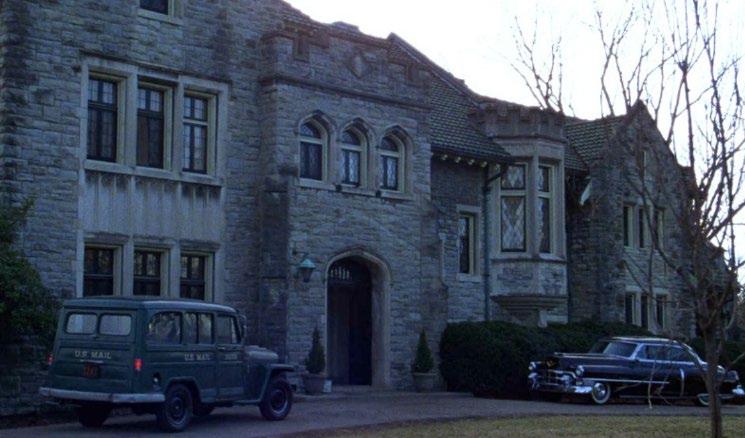


Their relationship is able to develop because of the shifts that occur in their individual autonomies, but these shifts are only possible because of the integral role each character takes on as protagonist. In David Bordwell’s “Pick Your Protagonist(s)” he suggests the film necessarily consists of two protagonists, Carol and Therese, rather than one. The notion that Carol and Therese both carry equally important roles in the film makes their transformations even more monumental. Without both characters as protagonists, the dynamic of the characters’ original states would be different. Naturally, with one protagonist, the focus would have been either on Carol, or on Therese, but not both. Both leads display drastic shifts to their characters’ autonomies, as clearly conveyed in both iterations of the restaurant scene.
MISE - EN - SCÈNE 19 Alexandria Jennings
Fig. 2 | Carol’s home and possessions symbolize her status, 00:16:02. The Weinstein Company, 2015.
Fig. 3 | Carol tenderly watches over Therese as she plays the piano, 00:36:27. The Weinstein Company, 2015.
Fig. 4 | Carol intently observes Therese as she demonstrates how to apply perfume, 01:08:18. The Weinstein Company, 2015.
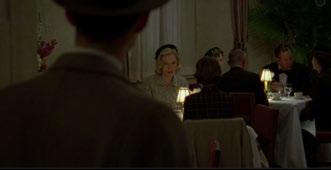


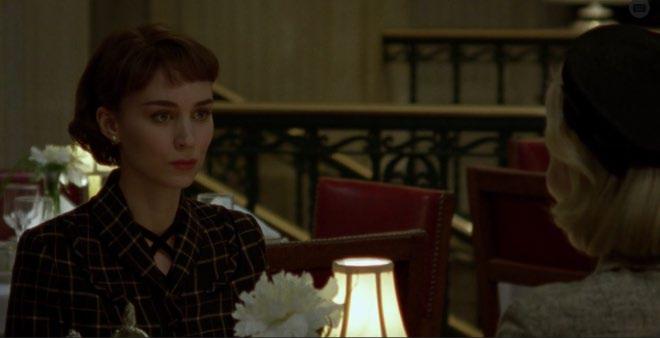
In the first iteration of the restaurant scene, Carol is the first character the viewer sees (Fig. 5). The camera is positioned to see Carol but not Therese, suggesting that Carol is the more dominant character in the frame and manages, in turn, to control the conversation.
We see Carol’s hand on Therese’s shoulder for about five seconds, forcing the eye to focus on Carol’s hand (Fig. 6). The length of time her hand is captured sitting on Therese’s shoulder signifies control, and lets the viewer know she is confidently touching Therese as though she possesses her.
During the first iteration of this scene, the audience is unaware that Jack (Trent Rowland) is a mutual friend of Richard’s. Carol leaves on what seems to be her own terms shortly after his arrival, giving the impression she has controlled the meeting’s purpose. In fact, it seems Carol’s departure is because she is largely uninterested and preoccupied with something of a higher importance. The framing of the handshake traps Therese within a tightly confined area, giving the illusion she is a prisoner of the shot with nowhere to go, thereby creating a physical and metaphorical fence (Fig. 7). Therese looks like a timorous child sitting at the table as she looks away while an adult transaction takes place.
The second iteration of this scene is portrayed much differently and occurs after Therese and Carol undergo major character transformations. Haynes shoots the same scene through a dramatically different lens, again inviting the audience to observe through Carol’s perspective.
In this iteration, instead of seeing Carol first, we see Therese, whose appearance verifies that she has undergone a physical transformation. She wears makeup she applied herself, her hair is different and no longer mirrors Rindy’s, and her wardrobe matches her age, all symbolizing growth and maturity (Fig. 8). Therese had grieved the end of their relationship, but she eventually landed a full-time job at The New York Times and discovered herself. What we did not know in the first iteration of the scene was that this meeting is the first one between Therese and Carol in months because Carol distanced herself to regain visiting rights of Rindy. This scene represents a drastic change in Carol, too. She divorced Harge (Kyle Chandler), found her own place, and even showed determination to work. These details suggest she has realized that hiding her sexuality is not worth the pain she has endured. This change means Carol no longer needs to rely on Therese to fill the space Rindy once occupied but, rather, she longs for Therese solely in a new capacity: as an equal partner. This time, a more dominant Therese takes up more of the frame than Carol. The same table light more clearly illuminates her face and shoulders. Carol’s face is completely absent from the scene, signaling a shift in control.
As Carol places her hand on Therese’s shoulder, a much different story is told—it is now evident that both characters have undergone a major shift in their own autonomies. Therese has turned down Carol’s offer to move in together, and Richard’s friend Jack has just arrived. In this iteration, it is clear that Carol does not leave on her own terms and feels inferior to Therese
Vol.07 No.01 | Spring 2022 20 Same Women, Altered Autonomy: A Close Look at the Perception of Power in Carol
Fig. 5 | Table light illuminates Carol’s face and shoulders, drawing direct attention to her, 00:03:20. The Weinstein Company, 2015.
Fig. 8 | After Therese’s transformation, she commands the conversation, 01:45:34. The Weinstein Company, 2015.
Fig. 6 | Carol’s dominant aura hypnotizes Therese when she is left alone at the table, 00:04:12. The Weinstein Company / Film 4 / Killer Films, 2015.
Fig. 7 | Jack, introduces himself to Carol, and traps Therese, 00:04:15. The Weinstein Company / Film 4 / Killer Films, 2015.
because she has been turned down. A shift in perspective allows the viewer to understand that it is actually Therese who influences Carol to leave the restaurant (Fig. 9). We see this transformation represented through the mise-en-scène when the scene is filmed through different camera angles (Fig. 10). In the second restaurant scene, Carol’s hand rests on Therese’s shoulder for a significantly shorter amount of time than in the first scene. This hesitancy to touch Therese indicates the gulf between them.
In the second iteration of the handshake scene, Therese no longer appears to be trapped behind Carol in the frame. This time, the gesture occurs behind Therese instead of in front of her, releasing her from the physical and metaphorical fence that once trapped her. The new camera angle puts her in front of the fence, freeing her old character. This liberation symbolizes the space she demanded from Carol throughout the second half of the film. Therese leaves on her own terms unlike before, where it appeared Carol left Therese.
Highsmith’s groundbreaking conclusion to The Price of Salt was preserved in Carol, leaving Haynes with a powerful dynamic to translate on screen. These recurring scenes act as the ultimate viewer’s guide in showcasing a monumental shift in power and drastic character transformations. Before a heartbroken Carol leaves the restaurant, she tells Therese if she were to change her mind, she can find her at the Oak Room where she will be dining with friends. It is through Therese’s necessary transformation that she can realize what she wants, which is to unconditionally belong with Carol. Upon this realization, she rushes to the Oak Room. I suggest that Carol and Therese’s relationship was only able to occur because of their autonomous transformations. It was not until Carol realized that Therese was not a stand-in for Rindy, and that she would be unhappy without Therese in her life, that Carol was able to take control and continue life on her own terms. For Therese,
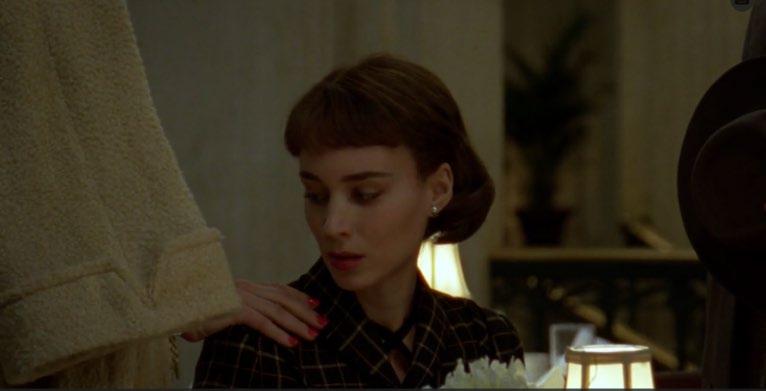
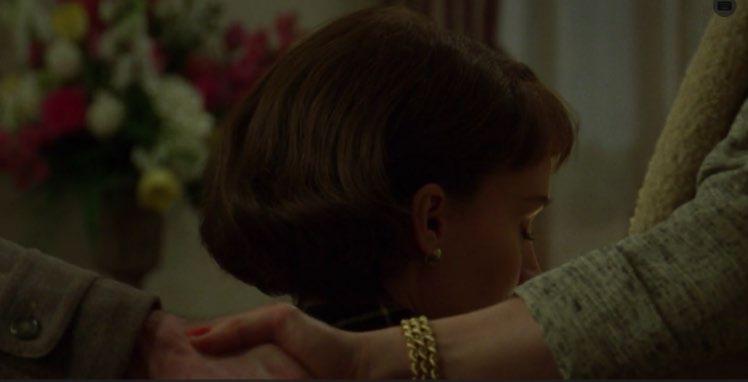
it was not until she was apart from Carol that she was afforded the room to grow and get to know herself, ultimately coming to understand that Carol’s decision to distance herself was one of love and not selfishness. At this pivotal point shown to us through two different lenses, both characters could reflect on their growth and, in the end, reunite.
WORKS CITED
Bordwell, David. “Pick Your Protagonist(s).” Observations on Film Art, 9 Jan. 2016,www.davidbordwell.net/blog/2016/01/09/ pick-your-protagonists/ Bradbury-Rance, Clara. Lesbian Cinema After Queer Theory. Edinburgh Press, 2019.
Carol. Directed by Todd Haynes, performances by Cate Blanchett, Rooney Mara, Sarah Paulson, and Kyle Chandler, The Weinstein Company, 2015. Merck, Mandy. “Negative Oedipus: Carol as Lesbian Romance and Maternal Melodrama.”SEQUENCE: Serial Studies in Media, Film and Music, vol. 2, no. 3, 2017.reframe.sussex. ac.uk/sequence2/archive/sequence-2-3/.
MISE - EN - SCÈNE 21 Alexandria Jennings
Fig. 9 | Therese influences Carol to leave the restaurant, 01:48:32. The Weinstein Company, 2015.
Fig. 10 | Therese ignores Carol as she leaves the restaurant, 01:48:36. The Weinstein Company, 2015.
Organized Clutter
The Precise Composition of The Diary of Anne Frank
BY MARSHALL DEUTELBAUM Purdue University
ABSTRACT
Because received opinion holds that the introduction of widescreen filmmaking presented directors with problems of mise-en-scène that they had to overcome, most discussions of CinemaScope composition focus on exceptional films that illustrate the ways especially adept directors organized the space in front of the camera to cope with these problems. This emphasis on the films of auteurs necessarily marginalizes the ordinary CinemaScope film as compositionally insignificant. My essay is not director-oriented. It does not entirely attribute either the composition of images or the blocking or disposition of actors to the director. Rather, it demonstrates that composition and blocking in CinemaScope films posed no problems because when the first films went into production the rules for both were already well-defined and embodies in the pair of grids that guided the design of a film’s sets. The underlying compositional clarity of the apparently cluttered sets in The Diary of Anne Frank (1959) illustrates the central importance of set design to widescreen composition.
In Giant: George Stevens, A Life on Film, writer and former television critic Marilyn Ann Moss describes how the director initially resisted filming The Diary of Anne Frank (George Stevens, 1959) in the widescreen CinemaScope format. As Moss explains, “Never a fan of the process, Stevens was convinced that its huge proportions would destroy the sense of intimacy he wanted” (246). The director’s son, George Stevens Jr., told Moss how his father, unable to overcome the studio’s commitment to CinemaScope, decided to create the claustrophobic feeling he deemed necessary despite being saddled with the unavoidable widescreen format. According to Stevens Jr., “the horizontal inclusiveness of the lens was the problem; so much more is in the frame. So Stevens designed beams and uprights into the set that could be used in framing” (246-247).
Whatever influence Stevens may have had on the film’s set designs, the fact is that they were actually designed by production designers Lyle Wheeler and George W. Davis, with the set’s furnishings decided upon by set decorators Walter M. Scott and Stuart A. Reiss. The quartet’s work earned them an Academy
Award for Best Art Direction-Interior Decoration, Black-andWhite. In this analysis, I examine the precision of their work more closely in order to highlight its importance in establishing the film’s visual composition, as well as the positioning of the actors. While both of these matters usually are attributed entirely to decisions made by a film’s director, my argument radically asserts that much of what is usually attributed to the director is dictated by the set’s design.
Consider, for example, this frame from the film in which Anne Frank (Millie Perkins) first sees the room that will be hers for the two years she spends in hiding from the Nazis (Fig. 1).
Ignore the specific details for the moment and see the image as a two-dimensional pattern of light and dark. Like all photographic images, the frame is at one and the same time a flat two-dimensional pattern of light and dark, and a three-dimensional illusion of space. Thus, the image of Anne’s room might be described more abstractly as a series of light and dark vertical sections or panels of varying widths and textures,
Vol.07 No.01 | Spring 2022 22
FEATURETTE



labelled A to N. While there is an overall balance of light and dark in the frame, there seems to be little other order, logic, or pattern to their arrangement. Indeed, the sections appear as much a hodge-podge jumble as the realistic details of the cluttered room.
Furthermore, there is reason to consider the image of the set as if it were the final drawing of the design. As Lyle Wheeler, longtime head of Twentieth Century-Fox’s Art
Department, told art and architecture historian Beverly Heisner in Hollywood Art, “The art director was the one who said what went into the construction of the set and his design had to be followed exactly by the crew and the set dressers. No liberties were taken with the art director’s design” (203). Viewed this way, one can discern that the placement of apparently jumbled items was guided initially by a grid divided into fourteen equal sections. Overlaying such a grid upon the frame reveals the underlying order of the image’s composition. The grid’s lines coincide with lines in the image at the edges of objects or at the places where one texture or shade of light or dark meets a contrasting pattern or value (Fig. 2). Columns J and K to the right of Anne do not immediately appear to fit this pattern and they coincide with the legs of an overturned chair. Between Columns G and H, the dividing line over Anne’s outstretched arm hides the line it coincides with—it is created by the space between the slats of the crate visible below her arm.
A second grid based upon the rabatment of the frame was also used to structure the set’s design. Rabatment, known to artists since the time of Giotto as a guide to composition within a rectangle, uses a line equal in length to the end of a rectangle to construct squares (A–B and D–E) at either end of the rectangle. The process leaves a vertical rectangle, shaded here a darker grey for emphasis between the squares (Fig. 3).1
In addition to shading the central vertical rectangle, I have added midlines and diagonals to the squares and rabatted grid overlaid on the frame from the film (Fig. 4).
The edges of the vertical rectangle coincide with the edge of the door Anne holds open and the line in the background hidden behind her head. The rabatted grid is often
1 I provide an explanation of rabatment and its uses in CinemaScope films in, “’Why Does It Look Like This?’ A Visual Primer of Early CinemaScope Composition.” Movie: A Journal of Film Criticism no. 9 (2021): 75-82. warwick.ac.uk/fac/arts/film/movie/contents/whydoesitlooklikethis_v04.pdf
MISE - EN - SCÈNE 23 Marshall Deutelbaum
Fig. 1 | The cluttered room that will become Anne’s bedroom, 00:14:26. Twentieth Century-Fox, 1959.
Fig. 2 | The overlaid grid reveals the image’s orderly composition, 00:14:26. Twentieth Century-Fox, 1959.

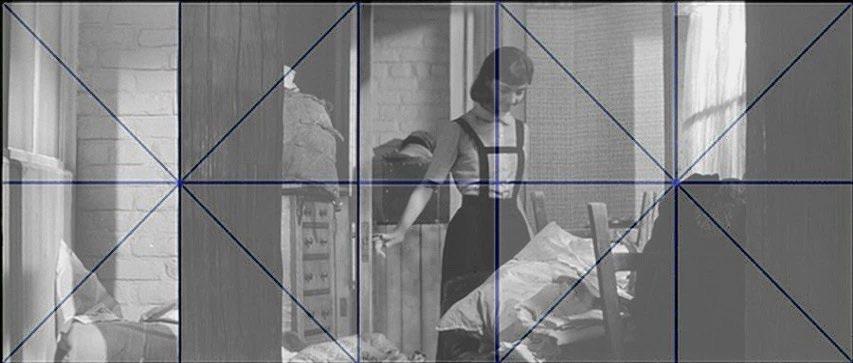

WORKS
CITED
Deutelbaum, Marshall. “’Why Does It Look Like This?’ A Visual Primer of Early CinemaScope Composition.” Movie: A Journal of Film Criticism, no. 9, 2021, pp. 75-82. warwick. ac.uk/fac/arts/film/movie/contents/whydoesitlooklikethis_ v04.pdf.
The Diary of Anne Frank. Directed by George Stevens, performances by Millie Perkins and Joseph Schildkraut, Twentieth Century-Fox, 1959.
used to determine the position of actors. A single actor usually occupies or overlaps the vertical rectangle, as Anne does here. If present, a second actor would be positioned on or close to the vertical midline of either square, as in this shot of Anne (in the vertical rectangle) with her father, Otto Frank (Joseph Schildkraut), positioned on the midline of the left square (Fig. 5).
I want to emphasize that the two grids I have described are used consistently throughout the film to compose the design of the sets and the disposition of actors. Together, they define the composition of the film’s images. In this regard, what I have described in this particular set is typical of what of any analyst would discover in the film’s other sets, as well. The example is typical, not unique.
This speculative attempt to discern in this single frame the progress of the set’s design from initial sketch to built set suggests how more intricate planning was involved in the film’s set design than the simple idea that the director “designed beams and uprights into the set that could be used in framing.” Indeed, it is the precise composition of the set’s design that actually determines the camera’s position; no other position could capture the composition designed into the set. A greater awareness of the function of set design offers insights into film production, thereby allowing audiences to recognize the central importance of set designers to a film’s overall visual logic.
Heisner, Beverly. Hollywood Art: Art Direction in the Days of the Great Studios. MacFarland, 1990.
Moss, Marilyn Ann. Giant: George Stevens, A Life on Film. University of Wisconsin Press, 2004.
Vol.07 No.01 | Spring 2022 24
Organized Clutter: The Precise Composition of The Diary of Anne Frank
Fig. 5 | Otto Frank gives Anne a diary, 00:25:40. Twentieth Century-Fox, 1959.
Fig. 3 | The inscribed squares created by rabatment of the CinemaScope frame with a rectangle between them
Fig. 4 | The rabatted frame overlaid upon the image, 00:14:26. Twentieth CenturyFox, 1959.
Cinematic Isolation and Entrapment in The Lobster
BY MAZYAR MAHAN University of Texas at Dallas
ABSTRACT
This essay examines specific elements of film form in the final scene of The Lobster (Yorgos Lanthimos, 2015) to illustrate how they contribute to the film's meaning. Through mise-en-scène and cinematography, the scene enforces the sense of isolation, loneliness, and entrapment that marginalized individuals experience in a society that does not recognize their fundamental human right to live as ordinary civilians. The Lobster is a portrayal of human society that uses characteristics such as race, ethnicity, sexual orientation, language, religion, and ability to define "normal" and "natural." Such a society punishes and excludes members who do not fit those criteria.
Society creates rules to define “natural” citizens. No matter how logical the rules are, those who do not follow will be considered misfits and punished in one way or another. In different temporal and spatial contexts, misfits become marginalized by their society. In the world of The Lobster (Yorgos Lanthimos, 2015), having a partner is the defining characteristic of being natural. Single people are marginalized, isolated, incarcerated, and even punished by losing their right to live as human beings. Despite being a science fiction film, The Lobster, in many ways, resembles our world. This essay examines specific elements of film form in the final scene of The Lobster to illustrate how they contribute to the film’s meaning. As I will demonstrate, through mise-enscène and cinematography, the scene enforces the sense of isolation, loneliness, and entrapment that marginalized individuals experience in a society that does not recognize their fundamental human right to live as ordinary civilians.
In a dystopian future, everyone is mandated by law to have a partner. Single adults are sent to a place called Hotel, in which they have only 45 days to find a partner among other guests. Those who cannot find someone with similar “defining characteristics” will be transformed into an animal of their choice. Those animals are released into a forest near the Hotel. David
(performed by Colin Farrell) loses his wife to another man, resulting in his being transferred to the Hotel. There, he observes other guests who seek out superficial similarities such as frequent nose bleeding, limping, heartlessness, and lisping, if only to generate the façade of partnership under the law and to continue living as humans, not animals.
After a while, David is almost ready to be transformed. He even chooses what animal he wants to be: a lobster. However, one day, he manages to escape the Hotel and joins Loners, a group of single people who live outside society in the woods. To resist the mainstream society’s peculiar laws, Loners have established their own rules. No one among them can have a partner or love relationship. Those who do not submit to the law will be punished by mutilation. At first, this seems like an ideal society for David because he is single. However, the situation changes when he falls in love with a group member known as Shortsighted Woman (performed by Rachel Weisz). Hiding the relationship is a challenging task. That is why, when they realize they both have myopia, David and Shortsighted Woman plan to return to the city because now they have a so-called defining characteristic that makes them a socially suitable couple. The leaders of Loners find out about their plan and, as a punishment, make Shortsighted
MISE - EN - SCÈNE 25
FEATURETTE
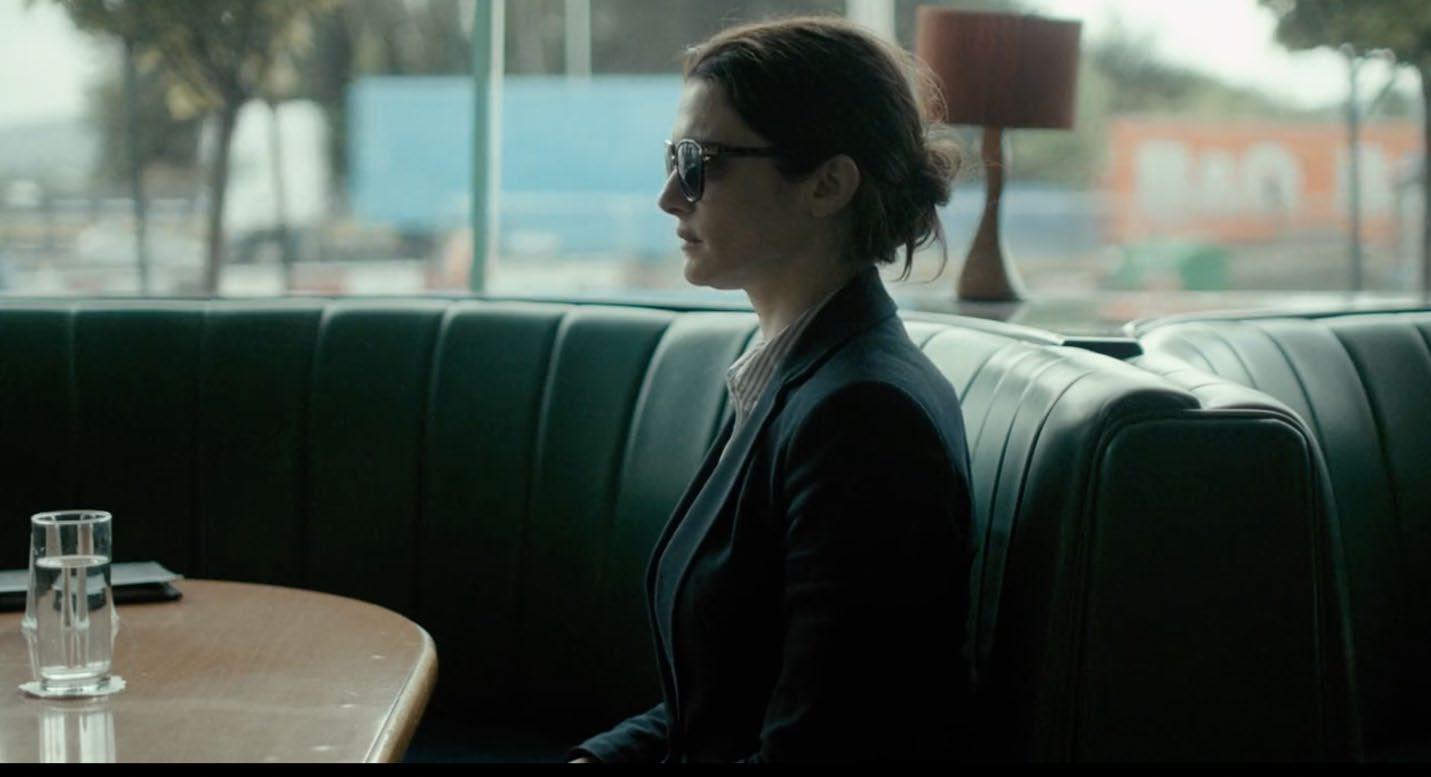

Woman blind. Now, she and David must keep living in the woods or find another common characteristic. David chooses the latter. He decides to blind himself to live with his love.
The scene under analysis comes from the film’s final sequence. By this point in the film, David and Shortsighted Woman have tried to be accepted by society or the members of a community, with their efforts having failed each time. First, they lost their “eligibility” to live in the city as soon as they became single. Then, they tried to join the Loners community. However, when the group finds out about their relationship, they are ousted and escape from the forest where Loners live. They subsequently enter a restaurant on the city’s outskirts, where David intends to execute his plan. In the dining room (Fig. 1), only the foreground, where the two characters sit, is in focus, a selective focus indicative of their isolation and detachment from their surroundings. They do not belong to this place because their relationship does not follow society’s rules. They are technically Loners, an “illegal” couple that has sneaked into the world of ordinary people. On the other hand, they do not actually belong to the world of Loners, who live in the forest shown in the far background of the scene.
The blurred background, created by long lenses, enforces the film’s claustrophobic atmosphere. Natural light—the soft diffused sunlight coming through the windows—is the only light source. This choice creates a low-key lighting effect, resulting in a somber, hopeless mood. The blue and green colour palette implies a sense of gloom and sadness. The colours are desaturated.
Such a choice produces a washed out look that suggests alienation and a bleak, unfortunate circumstance. The characters speak monotonously, which is indicative of the lack of emotion and passion in the world of the film.
The scene begins with a lateral medium shot of Shortsighted Woman. A piece of dramatic music, which ends after a few seconds, signals the transition from the previous scene. There is no establishing shot, but from the previous scene, we already know that they were going to a restaurant called Joel’s, located on the city’s outskirts. In the foreground, which is in focus, the woman is positioned in the centre of the frame, looking offscreen and to the left. She is sitting in a green curved-shaped booth, with a table of the same shape. Her position between the two curved-shaped objects evokes a sense of entrapment. The use of offscreen space is equally significant. Instead of positioning the two characters in a single frame or offering overthe-shoulder shots, the camera captures only one character in a single frame at a time. This technique adds to the sense of each character’s loneliness. In addition, the blurred background shows trees (likely the same forest from which the two characters have escaped) and some metal columns, and cars pass through the highway.
The scene cuts to a medium shot of David (Fig. 2). He is sitting on the other side of the table, looking at the woman’s fingers. Two other individuals in the restaurant are seated at the farthest point from David and the woman. In the foreground, his in-focused body occupies only one-third of the frame, on the right-hand side. The remainder of the frame is filled with the rows of booths in the restaurant, all blurred. David’s placement in the frame, the blurred background, the vertical lines on the booths, and the oblique lines formed by the restaurant’s windows create a sense of separation and isolation.
In contrast to the traditional approach to such scenes, in this scene, the camera does not offer over-the-shoulder shots of the two characters talking to each other. It is located beside one character, offering a lateral view of the other one. The side of the face angled towards the viewer is in the dark. Here, the camera offers a slightly low-angle shot of David looking at the woman’s fingers. The part of her hands that shows up in the foreground’s lower-right section of the frame is out of focus. David remains in focus, staring at the hands. The blurred hands can be interpreted as signifying David’s subjective view of them. He is not looking at them. Rather, he is thinking of what awaits him.
The scene cuts to the next shot where, for the first time, we see a medium two shot of the two characters in a single frame, sitting on the opposite sides of the couch, both smiling (Fig. 3). A slight high angle shot emphasizes their vulnerability. The direction of the light makes the foreground dark, forming a dark space between the two characters, implying their distance and evoking a sense of hopelessness. This dark space is symmetrical and parallel to the mass of trees that stands in the background. Since the two characters come from the forest, where Loners reside, the frame’s composition associates loneliness with the darkness. While the two characters smile at each other, a family passes by
Vol.07 No.01 | Spring 2022 26 Cinematic Isolation and Entrapment in The Lobster
Fig. 1 | The restaurant's dining room, 01:45:48. Film4, Screen Ireland, 2015.
Fig. 2 | A medium shot of David, 01:46:08. Film4, Screen Ireland, 2015.
the window. The characters’ smiles, captured in a single shot, and the presence of a family within the same frame, work together to suggest a hopeful future for them, a future in which they can be together. For a brief moment, the balanced, symmetrical composition in the scene evokes the promise of hope that maybe they will be able to unite after all. In this shot, the emphasis on the vertical lines formed by water glasses, the salt and pepper shakers, the characters’ bodies, the lines on the couch, the table lamps, the trees on the two sides of the frame, the metal columns, and even the road hazard cones creates a sense of unification between the two characters. This feeling is heightened by the depiction of most of the objects mentioned above in pairs: the pepper and salt shakers, water glasses, and table lamps, for example. After a short dialogue about getting used to blindness, David takes the knife and stands up to go to the restroom.
The scene cuts to a corridor that leads to the restroom (Fig. 4). The light coming through the exit door and the ceiling lamps at the end of the hall are the only light sources. Such lighting creates a dark space in the foreground and a small bright one in the background. The camera is static, but David’s move provides a transition from a medium shot to a long shot.
In contrast to the end of the hall, which is in focus, the foreground is out of focus, suggesting that David is moving from ambiguity and uncertainty to decisiveness. Granted, he is supposed to blind himself, but maybe blindness is the only way to unite with someone he loves very much. In addition, in the centre midground and background, a red sign (pointing to the toilets) and a green sign (pointing to the exit door) are emphasized. David can choose the toilets or take the exit door and run. If he follows the red sign, there will be blood waiting for him in the restroom. Alternatively, if he decides to run, like the lonely icon on the green sign, he will be alone and, consequently, need to go back to the forest and live as a Loner. Further still, the two circular bright windows on the exit door metaphorize human eyes. If he takes the door, he will still have his eyes, and if not, he must turn right into an unknown destiny. The tight framing also emphasizes David’s entrapment and isolation. When he reaches the end of the hall, he turns to the right, making clear that he has chosen blindness.
The scene cuts to the bathroom (Fig. 5). The camera offers a full lateral shot of David with a knife in his right hand, pointing it at his eyes. A wall divides the frame into two parts, with a window on the left side the only light source. Such lighting, in addition to the composition, put David in a white vertical frame. It also mirrors a much darker version of the room on the right, foreshadowing what is to come.
The camera cuts to a medium shot of David with the knife in his hand (Fig. 6). He picks up some tissues and puts them in his mouth. The natural backlighting renders his face dark and undetectable. His face is seen in the mirror as well. When he raises his hand to put the knife in his eye, his hand is masked by the tissue holder. We only see the tip of the knife pointing at his eyes, as if someone else—perhaps society, culture, the law, or the
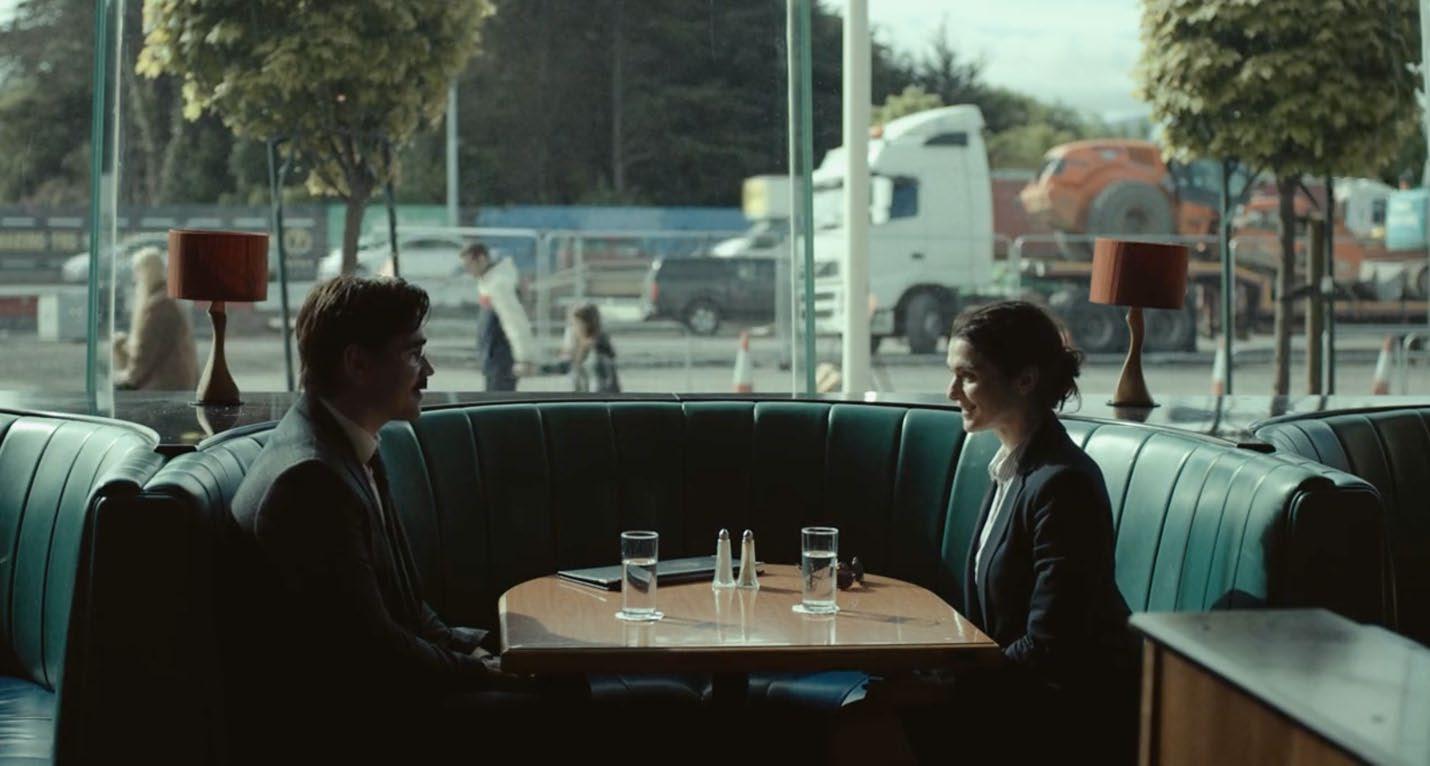



MISE - EN - SCÈNE 27 Mazyar Mahan
Fig. 5 | David is trying to blind himself in the bathroom, 01:48:16. Film4, Screen Ireland, 2015.
Fig. 3 | A medium two shot of David and Shortsighted Woman, 01:46:45. Film4, Screen Ireland, 2015.
Fig. 4 | The corridor, 01:48:03. Film4, Screen Ireland, 2015.
Fig. 6 | A medium shot of David with the knife in his hand, 01:48:50. Film4, Screen Ireland, 2015.

government— is doing it to him. He wants to be with someone he loves, but he cannot unless he blinds himself.
While David struggles with executing, the scene cuts back to the restaurant’s dining room, where Shortsighted Woman, sitting in the same booth, waits for David (Fig. 7). The camera replicates the scene’s earlier two shot of David and Shortsighted Woman, except this time, the woman sits alone, her blind eyes looking at where David had sat before. Her glass is empty, suggesting the passage of time. She moves her head to the window as if she is looking outside, at the forest. Maybe it has been enough time for her to realize that she must go back to the woods because David will not be coming back. A couple passes by the window. The family life the woman and David had planned is passing in equal measure, becoming unreachable. The scene then cuts to
darkness and focusses there for a few seconds before the film’s credit reel begins. Does it mean David has blinded himself, or does this dark interlude allude to the tragic fate of these two characters?
Whatever the case may be, The Lobster is a portrayal of human society, a society that defines “normal” and “natural” through the lenses of various criteria, including race, ethnicity, sexual orientation, language, religion, ability, etc., and punishes and excludes those who do not fit those criteria. These rules may change from time to time and from one place to another. They might even seem ridiculous in the eyes of outsiders and observers. However, as The Lobster shows, any form of exclusion is dangerous and absurd and can potentially hurt all members of a society regardless of their status and qualifications.
WORKS CITED
Vol.07 No.01 | Spring 2022 28 Cinematic Isolation and Entrapment in The Lobster
The Lobster. Yorgos Lanthimos. Film4, Screen Ireland, 2015.
Fig. 7 | The final shot, 01:49:00. Film4, Screen Ireland, 2015.
No Simple Answers and No Simple Narratives
An Interview with Director Cathy Brady
BY PAUL RISKER Independent Film Scholar
Two sisters are reunited when Kelly (Nika McGuigan), missing and feared dead, returns home. Lauren’s (Nora-Jane Noone) conflicting feelings of relief and anger are complicated by her sister’s mental fragility, and the intense bond of a shared childhood trauma (Fig. 1). Living on the Irish border in a community that was torn apart by the Troubles, Kelly and Lauren’s anxieties are as political as they are personal, and her return unsettles her sister’s peace at home and in the community.
Irish filmmaker Cathy Brady’s feature debut Wildfire (2019) is an emotionally moving and unsettling piece of filmmaking. “There are no simple answers and there are no simple narratives” says the director, whose story looks at the complexity of truth. The wounds of a country ripped apart by religious and political violence are not fully healed, and Brady avoids a simplification of the interaction between past, present, and future. She instead nestles into the complexity of how personal and social truths are communicated, and the different forms of truth that comprise this personal journey of closure for the sisters.
Following the screenings of Wildfire at the 2019 editions of the Toronto International Film Festival and the BFI London Film Festival, Brady discussed with MSJ her interest in the connection between the mind, body, and spirit. She also spoke about the appeal of complicated characters and the magical nature of film that is influenced by one’s life experiences.
PR: Wildfire strikes me as a film that will be difficult to forget because there are scenes that leave a lasting impression. One of those scenes occurs in the bar, where a playful encounter between the two sisters and two men suddenly turns violent, and then ends abruptly. Throughout the film those key moments, as in life, are often small and concise.
CB: …The structure of how the film was made, it has a different DNA to something that I’m sitting down at the laptop and hitting my story beats, because that’s what the book says you do at this point. When it’s built and grounded in research, and hearing real stories, and you’re trying to feed that through, it sometimes will take a looser organic shape. For some people that can be unsatisfying because they’re so used to subconsciously thinking, “Okay, so they have to pay this off; where’s that going to pay off?”
These men live in the town and the girls confront them, but there’s not going to be a massive retribution. Their biggest retribution is going to be dancing and going, “Fuck you” in the bar in their own way, and that’s it – that’s the smallness and the truth at the moment (Fig. 2).
They’re not going to go in there and set the world on fire. They’re not going to all of a sudden expose them in the papers because it’s not a conspiracy thriller. It’s a very personal story about what personal retribution feels like, and that can just be the freedom to stand up and say, “I’m not afraid of you.” It’s confronting the bully in the school yard and that’s all they get to do. There’s no massive satisfaction because they’re chucked out, but there’s a freedom in that. The scale of it might feel very small, but in someone’s life, that’s massive.
PR: What you convey through this story is the tentative nature of peace, because there are those in Northern Ireland who see the Good Friday Agreement as a betrayal. One of the interesting ideas that emerges out of the drama is the idea of truth and honesty. There’s a
MISE - EN - SCÈNE 29
INTERVIEWS

time and place to be honest, but we must be aware of the sensitivity surrounding the truth.
CB: That’s interesting about truth and who’s ready to hear it. I come from a family where again, do you really need to speak your mind, is that helpful? I’ve grown up questioning that, and the truth is important, but sometimes you just realise that for some people the truth is just too difficult to hear. They’re not ready in that part of their life to hear whatever truth it is, and that has been a hard lesson for me to learn.
There’s something about the mother’s story and Kelly wanting to know the truth, and how that’s all that matters. She thinks if she somehow gets the truth, she’ll be healed, but the event has still happened. Veronica [their aunt] has tried to suppress it and Lauren is terrified of it because she’s so close to the truth. It’s very difficult to know about secrets and families, and how hidden the truth is. I do feel that somehow it’s different for each of us.
For the likes of Veronica, I don’t know if she will ever come to terms that the mother’s death was through suicide because it’s too difficult for her to take on, whereas for Lauren and Kelly, it’s something that they need to assimilate. But equally by assimilating that, they also need to know that she loved them the best she could, and that’s the real truth, rather than she died by suicide.
The bigger truth is the woman was struggling and it just meant that her love might not have been as supportive as other parents, but it didn’t mean that her love was any less. It was just everything she could give, and so it’s also understanding what the truth is - it’s the truth in retribution and justice. All of those things are so interesting and difficult, and the minute you try to make it black and white, you’re in trouble because the truth is very complex.
PR: In an early scene, Kelly startled by a barking dog runs off and passes a placard that reads, “Prepared for peace. Ready for war.” From the beginning, you establish the murky grey reality of the country’s past and present.
CB: Have you ever heard of double bind? It’s a therapy term where you say one thing, but your behaviour means another thing. You push them away, but you pull them in at the same time.
They say there’s a link to double bind theory in schizophrenia, in terms of family dynamics. A child doesn’t know how to read a situation because they’re too young, so there’s a split, and there’s something in the behaviour that can cause schizophrenia in later life. There’s something double bind about, “Prepared for peace. Ready for war,” something passive-aggressive and untrustworthy, but equally it’s promising, and it’s very complex.
Vol.07 No.01 | Spring 2022 30 No Simple Answers and No Simple Narratives: An Interview with Director Cathy Brady
Fig. 1 | Set photograph featuring Lauren (Nora-Jane Noone) and Kelly (Nika McGuigan) from the nightclub scene where a playful encounter turns violent. Photograph by Aidan Monaghan, 2019.
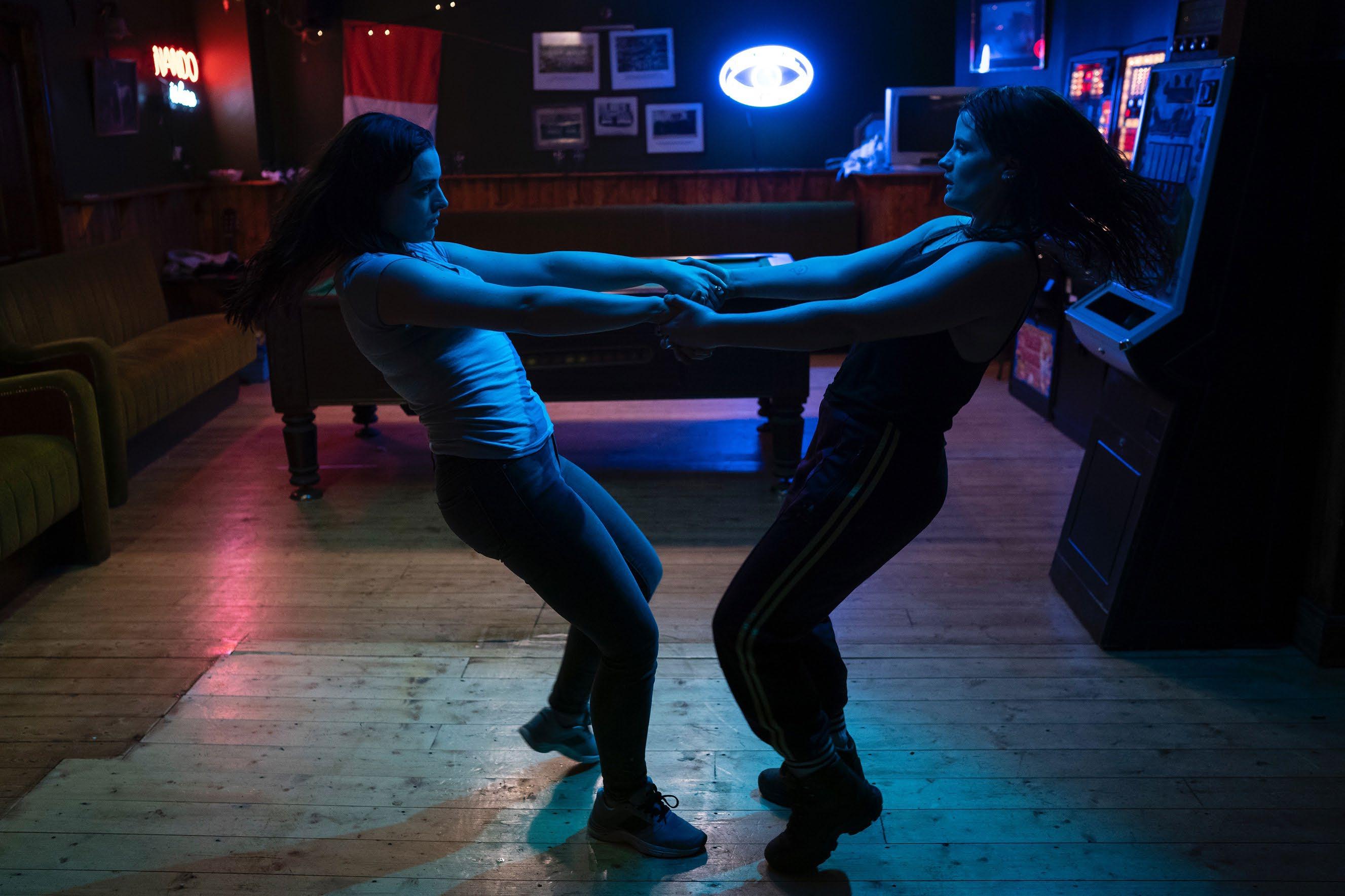
PR: I found the scene in the warehouse when Lauren is on the verge of a meltdown to be disturbing. From my personal experiences, it felt terrifyingly genuine, and I hope that audiences appreciate the insight the film offers into mental health and anxiety, and encourages compassion and understanding through empathy.
CB: … There’s this guy in Northern Ireland, he runs this Intergenerational Trauma Conference every year. He’d heard about Wildfire and he maybe wanted to talk about the film in terms of the conference. He sent me an article by Marshall Rosenberg, for who it’s important to realise that it’s not an illness, it’s an injury. And it’s an injury that can be healed; we just don’t know how to do it yet. There’s a lack of understanding, discussion, and communication, and it’s true that we will only get to it through compassion.
The conference is a way to start the conversation about trauma and trauma recovery, but we’re only beginning to scratch the surface, and what you’re saying, I think a lot of it’s coming from fear. People will go to the doctor if they have a sprained ankle or broken leg, they’ll go straight to A&E, but there’s such a lack of understanding of how the mind works. Even the idea of it being so rooted in the past, and then when you’re hearing of inter-generational trauma, you realise that it’s not even your own, it’s passed on. We’re yet to understand, and it feels that Marshall Rosenberg’s work is starting to put words and discussion into
these things. But it’s difficult when the country is being led by people who aren’t willing to think in that way, because they’re thinking about profits before people. And when it comes to mental health facilities, they’re constantly losing funding.
Psychosis often can be a spiritual awakening, and there are all these these different areas that we don’t know how to talk about yet. We’re so used to one vision, and the power of storytelling is that it just allows us to break down some barriers and step inside someone’s shoes.
Lauren’s story, especially in the warehouse and how close she was to the brink, she feels unseen and unheard by the world she’s in, and judged. But not only that, she’s denying part of herself that wants to speak the truth and that’s eating away at her. It’s difficult to contain that all in your body without it coming out in some way. So I’m fascinated by the mind, body, and spirit connection, and complicated characters. There are no simple answers and there are no simple narratives.
PR: Could we also challenge the idea of a film being in a permanent form as an over-simplification? The way we respond to a film is influenced by our life experiences, and who we are in the moment. If our response to a film is flexible, then is a film an impermanent form?
CB: Isn’t that the power of sitting in the cinema and witnessing a film? There has been many a film I’ve absolutely adored, and
MISE - EN - SCÈNE 31 Paul Risker
Fig. 2 | Lauren and Kelly. Photograph by Aidan Monaghan, 2019.
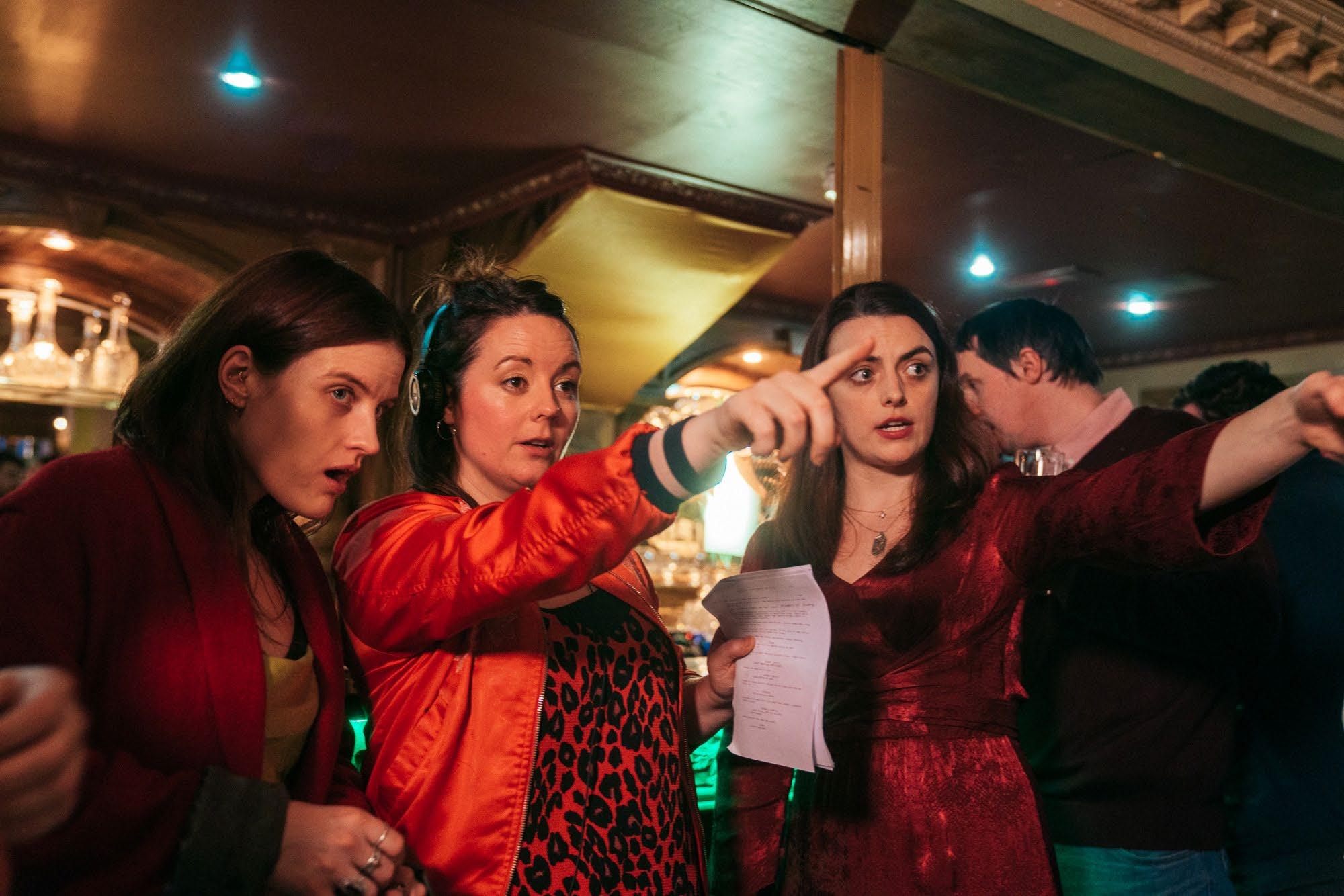
the company I’ve been in absolutely hated it. Junebug (2005) was one of those films - I loved it. I was laughing, crying, and the company I was in thought that it was the biggest load of shit. I was like, “What!” I couldn’t understand it, but sometimes for whatever reason, it just touches something in you, and I think you’re right that it’s about human behaviour.
The films that really intrigue me, there’s a gap between what is said, what you see and your own understanding. I prefer films where I am asked to step in, and it’s not just being an observer. There’s something quite active about that because you’re having to piece information like you would if you were in a room and you’re trying to read the situation, and piece it together.
It’s funny because there are other films, and I remember someone saying, “Oh, you should watch Robert Bresson’s work, I think you’d love it,” and I sat back and I couldn’t get it. “What’s wrong with me? I just don’t understand what it is.” Sometimes there’s a magic to why stories work for you, and how films will find you at a certain time. But when they do, it feels very wholesome and pure, and it feels like you’re on a wave with something.
You can also tell from the first few frames of a film, and those moments are incredibly special because there’s just something about time. I remember the film Her (2013) by Spike Jonze, and I knew from the first minutes of sitting in that cinema,
the sound of the music and the first images. It was like a holy connection, but it’s not like it’s a mind-blowing film. There was a sense of loneliness that just spoke to me so fucking loudly, that I felt so sad and so happy, and so touched. But I’ve never seen that film again because I’m so afraid of not having the same connection.
PR: I remember the loneliness of Lost in Translation (2003) speaking to me when I watched it in the cinema, and yet it failed to resonate as powerfully on a repeat viewing. And another film, Sun Choke (2015), I remember the first viewing being more focused on the sensory experience, whereas repeat viewings became more narrative driven.
CB:It’s a dark magic that we’ll never understand. You’re right, I never really thought about cinema being so malleable. I suppose art is malleable as well, just because it’s captured on, well now it’s a DCP [Digital Cinema Package], it doesn’t mean that it doesn’t change. When you think of Ken Loach’s films, it was very much state of the nation, and you had to make a point, and you had to make it now. It’s hard to make a piece of work that is so incredibly timeless.
PR: It’s important to remember that to experience stories is a privilege, because we will never have access to or the opportunity to watch every film that we’d like to see.
Vol.07 No.01 | Spring 2022 32 No Simple Answers and No Simple Narratives: An Interview with Director Cathy Brady
Fig. 3 | On the Wildfire set with Nika McGuigan, director Cathy Brady, and Nora-Jane Noone. Photograph by Aidan Monaghan, 2019.
CB: … Covid has taken from us a lot of things that we definitely took for granted – even just the cinema experience. Never did I think that we’d be premiering to a virtual audience. Again, we just got so accustomed to the norm that we forgot the privilege of sitting in a darkened room and sharing a story with strangers. When the opportunity comes and I’m able to sit in a cinema again, I hope I don’t take that for granted because I definitely did.
PR: And our interests such as the arts feeds our sense of self.
CB: Totally. A sense of self and also a sense of purpose. Sometimes it’s difficult to know what purpose is, but through other people, hearing and seeing their stories, it can sometimes give you a sense of connection and purpose again.
PR: We can find it easier to feel empathy for characters in a story than people in everyday life, where the stakes are real. Cinema offers us an opportunity to perhaps confront the difficult experiences that we would otherwise retreat from, that feeds our own self-awareness.
CB: Well, the other thing that stories and cinema offers is it can be more real because you can see a private moment with a character that often people will never reveal to anyone. You get to journey into a private moment or a public moment, and you get to understand what they’re hiding. Through that you get a sense of what we’re all hiding, and that’s where the empathy comes from.
Cinema allows the opportunity to again feel a connection and to feel heard. It’s not like a book, there’s something when you witness it, when you see a person do something and see a person live through it. A book we’re fully using our imagination, and there is something about cinema that feels captured.
PR: You seem to understand when to be in close and when to be distant, especially in the penultimate aerial shot of the sisters, where distance is more effective than being in a tight close-up. And in an earlier scene when they’re sat in the garden, you choose to cut away from the two characters as they talk.
CB:The shot in the garden for example, asks you to sit there with them. It probably held a little longer than it should, but the idea is, that’s it, that’s all they’ve got, that’s the view. How would you live in that experience? How would you experience that and the beauty just beyond that fence? And the quietness and awkwardness of that moment, and not knowing what to say. The fact that you’re not looking at their faces, you’re somehow sitting there with them, and you’re looking at that view.
There was a Norwegian film I’d seen a couple of years ago, and every so often they would use an aerial shot, and it really blew my mind its power. I remember there was one scene, this nineteen-year-old guy, who shouldn’t be a father just yet and his baby has a dirty nappy. He’s in the car park and he’s panicking because he doesn’t know what to do. Instead of being down there with him changing the nappy, all of a sudden it went to top shot
and you were looking down. You were watching people look at him and make judgements about him, and there was something about the God’s eye view that made me think, “Oh my God, I can see how people work, and they don’t understand how difficult this moment is for him.”
I was interested about somehow bringing that language into Wildfire. I felt there was a certain idea of fate within the film that I wanted to play with. On some level these girls are trying to break a karmic cycle of some kind, and there’s something about this God’s eye view. Even in the music there’s a certain sense of fate and the hauntingness of the voice, that I felt like the mother was with them, and somehow they had journey to this point in order to overcome something.
So there was a presence about the God’s eye shot that would say the mother is released in a sense and the girls are released, but equally from this viewpoint we see that these girls are walking towards help. Are we capable of giving the help that they need, and that’s something that the higher shot provides, something beyond our own human perspective. It’s broader also in sense of time and how things work.
PR: Films can remind us that there is often a lack of a beginning, a middle, and an end, rather chapters of our lives bleed into one another.
CB: Every so often I think, “Aren’t humans strange and wonderful?” [Laughs] There’s so much about storytelling that reminds us of our lives because we are all living our own characters, our own worlds and our own stories (Fig. 3).
I believe you come to life with a sense of who you are and what you’re about, and not everybody gets to live that purpose. But when you find the right people, or you find the right interest, there’s something that starts to click, and your sense of purpose comes alive. Through characters we get to see what happens when they diverge from their sense of purpose, or when they drive towards it, how their world changes, and there’s something about that that’s interesting
MISE - EN - SCÈNE 33 Paul Risker
Of Other Homes
Creating Space for Belongingness in
Midsommar
BY MATTHEW SCIPIONE Curry College
ABSTRACT
Using Michel Foucault’s concept of “heterotopias” (other spaces) and “heterochronies” (other times), this essay argues that space and time are essential to understanding Ari Aster’s Midsommar. It examines how Aster uses Hårga’s bygone civilization as a counter-space of deviation that exists outside of modernity. Aster’s spatiotemporal filmmaking techniques serve to visualize the heroine’s journey of finding a place to call home. The Swedish village creates a heterotopic space that allows her to belong. Hårga becomes an other home for the film’s protagonist.
“There’s no place like home.” – Dorothy, The Wizard of Oz
Ari Aster’s Midsommar (2019) remaps the construct of home by exploring the seasonal nature of identity, community, and family. Midsommar is a female coming-of-age film that borrows from fairy tales and folk horror myths. Told in broad daylight, the narrative follows the white American heroine Dani (Florence Pugh) as she travels to an all-white Swedish village with her boyfriend (Jack Reynor) and his anthropologist friends (Will Poulter, Vilhelm Blomgren, and William Jackson Harper) to partake in a pagan midsummer festival. Set against this all-male group, Dani is seen throughout the film as a female outsider who is socially detached from others and emotionally estranged from her boyfriend. While Dani’s toxic relationship with Christian is on the brink of collapsing, the death of her biological family keeps them together momentarily as they travel abroad. Upon their arrival in Sweden, a grieving Dani is spatiotemporally transported to a pastoral land that exists outside of modernity. The trip enables her to enter a faraway commune that is drastically different from her home back in the United States. Over the course of the film, Dani begins to see Hårga as a magical place—somewhere over the rainbow.
Aster uses “movement” as a filmmaking aesthetic to display Dani’s dislocation and alienation as a displaced white woman with no family or home (Giannetti 95). Camera movement, character movement, and visual effects movement serve to visualize Dani’s emotionally unstable state of being. According to Louis Giannetti, the technique of “moving the camera enhances three-dimensional space” because it immerses viewers into the shot’s space (117). This movement of the camera, combined with the flow of bodies, locations, objects, or frames per second within the composition, creates what Gilles Deleuze calls the “movement-image” (Deleuze 2). It helps to see the movement-image as an “imaging-of-movement,” reframing the term as a verb rather than as a noun (Vitale). From this angle, movement-images report the world in motion through visual artistry. Thus, filming modern Americans within Hårga’s bygone civilization accentuates current tensions about belonging. Midsommar displays how movement-images establish an important link between the actor and the environment in a “costume film” (Deleuze 163). Aster’s movement-images displace viewers by showing Dani move through this ancient space that uses sets, wardrobes, and rituals to indicate a former time. Studying
Vol.07 No.01 | Spring 2022 34
UNDERGRADUATE SCHOLARSHIP
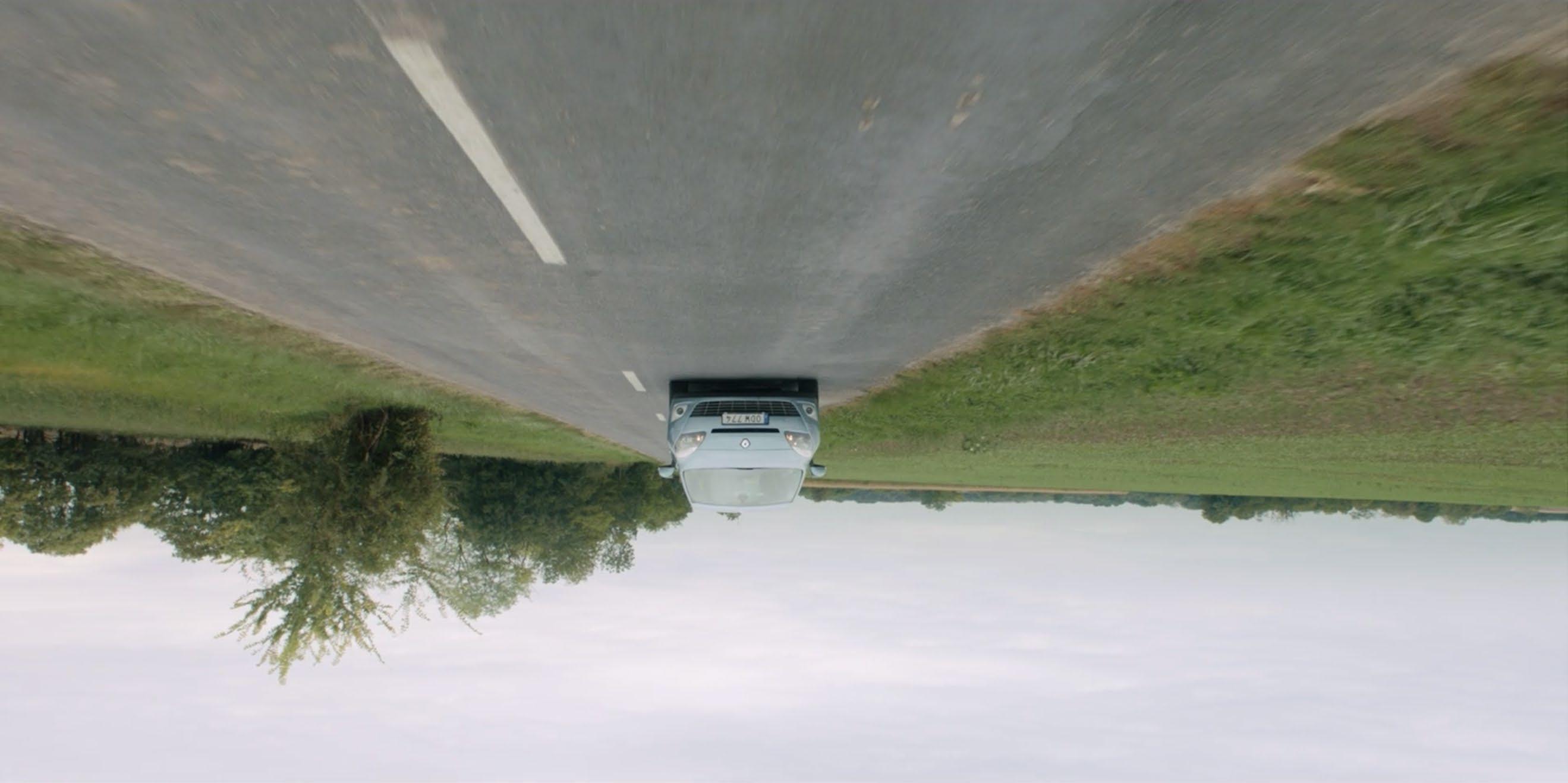
Midsommar through this Deleuzian lens focuses attention on how movement can present anxieties and fears happening now in the global imaginary.
Movement-images visualize Dani’s “no sense of place” and lack of belonging (Appadurai 29). Arjun Appadurai accounts for such displacements by using the suffix of -scape: “Technoscapes” (flows of technology), “mediascapes” (flows of media), “financescapes” (flows of capital), “ideoscapes” (flows of ideology), and “ethnoscapes” (flows of people). Appadurai’s anthropological framework helps moviegoers understand the ever-shifting viewpoints, ever-changing relationships, and ever-surprising contradictions found within a globalizing environment. To Appadurai, today’s “imagined worlds” are rootless and constantly in flux (33). In addition to the death of her parents and sister, the age of modernity uproots Dani, making her feel neither here nor there. She is seen utterly devoid of forming national attachments to her country, social attachments to her community, or sexual attachments to her boyfriend. Instead, she must travel from America’s multiracial and multicultural heterogeneous society to Sweden’s monoracial and monocultural homogeneous society. Unlike the diversifying nature of modern America, whiteness connects the Hårga people because they are a civilization that has carefully preserved the bloodline of their Northern European heritage. Aster uses geographic displacement and cinematic movement as storytelling techniques to illuminate how identity, geography, and anthropology relate to the film’s theme of finding a place to call home.
Hårga becomes an other home for Dani that disrupts the time and space of modernity. Building on Michel Foucault’s concept of “heterotopias” (other spaces) and “heterochronies” (other times), Aster has Dani move through both space and
time to gain a sense of belonging (Foucault 26). In “Of Other Spaces,” Foucault contests the traditional notion of linear time, asserting that concepts of time have been understood in various ways, under varying historical circumstances. Foucault’s idea corresponds with how people understand spaces over time. Unlike a “utopia” that Foucault describes as an unreal space, a heterotopia is an actual space that is impacted by culture (24). According to Foucault, all cultures are heterotopias. Foucault postulates that a heterotopia is a “simultaneously mythic and real contestation of the space in which we live” (24). These counter-spaces of deviation are bound together because they are all outside of the ordinary, containing a disruption of time and space.
In Midsommar , the Swedish village serves as a heterotopic space that allows Dani to spatiotemporally move into a community that treats her like family. The cinematography echoes Foucault’s theory and foreshadows Dani’s journey when the group is en route to Hårga. As they drive towards the isolated commune in the province of Hälsingland, the camera flies over the car and flips upside down once it reaches the other side of the vehicle (Fig. 1). This one-hundred-eighty degree drone shot displays that they are entering a strange counter-space that will upend Dani’s world and turn her life around. Aster uses his camerawork to comment on anxieties and fears that have been heightened by global flows. This is especially evident in the proceeding upside down shot where the car is seen driving underneath a strategically placed road banner. Translated from Swedish, the sign reads “Stop mass immigration to Hälsingland,” which aligns with the Hårga people’s worldview of securing and preserving their white culture in today’s global era.
MISE - EN - SCÈNE 35 Matthew Scipione
Fig. 1 | Car en route to Hårga, 00:24:38. A24, 2019.

The narrative follows Dani as she moves from the United States to Hårga and from the present to the past. As Foucault suggests, heterotopias have both a disrupting spatial dimension and an unsettling temporal dimension. Since heterotopias are “often linked to slices in time,” they often arise from an “absolute break with their traditional time” (26). Aster develops this heterochronia by having the film centered around the celebration of midsummer. This holiday time ruptures normal time by providing a special occasion that exists outside of contemporary festivities and everyday activities. It is also crucial that the group’s arrival date at Hårga coincides with Dani’s birthday. Traditionally, holidays and birthdays are celebratory moments in time that are spent at home with family. However, Aster challenges these conventional ideas of time by having Dani enter a foreign terrain and time with no familial connections. Christian forgetting Dani’s birthday illustrates that, in addition to having no sense of place, Dani has no sense of time. Dani’s most basic temporal relationship with the world is treated as unimportant and insignificant to those closest to her.
Aster particularly sheds light on Giannetti’s, Deleuze’s, Appadurai’s, and Foucault’s ideas during the liminal scene right before the group officially enters Hårga. Upon their arrival, the Americans all take psychotropic drugs together under Sweden’s midnight sun (Fig. 2). Bolstering Foucault’s notion of a heterochronia, this twenty-four-hour period of sunlight disrupts the characters’ and spectators’ perception of time. As the heterotopic scene progresses, Dani begins to experience panic-stricken anxiety from the mushrooms once Mark (Will Poulter) says “You guys are like my family.” Emotionally impacted by the drugs and Mark’s reference to family, Dani undergoes a bad trip. Aster subjectively presents Dani’s hallucinatory experience from her
altered perspective. The steadicam single take follows Dani as she stands up and walks away from the group. Simultaneously, Aster uproots the shot and creates a fluid camera movement that makes the wondrous natural landscape appear somewhat surreal because nothing in nature moves this way. Tracking her actions, the digital Panavision Millennium DXL2 camera moves a full three-hundred-eighty degrees. This three-hundred-eighty degree movement-image showcases the instability that Dani brings to the already unstable nature of the global era. In addition to the physical movement produced by the camera and character, Aster uses visual effects to digitally move Dani’s surroundings. This digital movement created through modern post-production technology immerses viewers into Dani’s subjectivity by distorting environmental elements and warping human faces. The tripping visual effects become fully exaggerated when Dani races toward a nearby outhouse. As the effects become more pronounced, spectators get to experience Dani’s heightened sense of disorientation firsthand. Aster uses various cinematic movements to express the liminality of Dani’s Othered state of being.
Aster’s exploration of heterotopias and heterochronies culminates once Dani enters the shadowy outhouse. Looking at her own reflection, Dani imagines seeing her dead sister in the mirror (Fig. 3). Once she glances over her shoulder, her sister disappears and Dani is left looking in the mirror as the digital movement of the visual effects begins to deform her face. This subjective over the shoulder shot illuminates how the film’s aesthetic use of movement mirrors Dani’s relationship with space and time. Foucault’s theory explains the deeper significance of Dani’s reflected gaze because he postulates that a mirror serves as the ideal example of a heterotopia. According to Foucault, a
Vol.07 No.01 | Spring 2022 36 Of Other Homes: Creating Space for Belongingness in Midsommar
Fig. 2 | Americans take psychotropic drugs, 00:29:06. A24, 2019.

mirror is a “placeless place” that disrupts one’s spatial relationship with the world by converging real and unreal spaces (24). Foucault writes that the mirror “makes this place that I occupy at the moment when I look at myself in the glass at once absolutely real, connected with all the space that surrounds it, and absolutely unreal, since in order to be perceived it has to pass through this virtual point which is over there” (24). Similar to Foucault, Aster believes mirrors allow people to redefine the space they inhabit as heterotopic. When Dani looks into the mirror, she is looking at a version of herself that is surrounded by both an existent and nonexistent environment that suspends her in space. Aster has repeatedly framed Dani’s on-screen movement within mirrors beforehand. She is seen through the looking-glass three times prior to either grabbing her Ativan medication, talking to Christian’s friends, or crying in an airplane bathroom. However, what makes this last mirror shot in the outhouse so unique is the inclusion of Dani’s sister. Visualizing her no sense of place or time, the mirror shot shows Dani inhabiting a placeless place that spatiotemporally exists neither here nor there. In this liminal moment, Dani is seen moving in-between different places, times, and cultures. She has reached a turning point in her crisis where she must create space for belongingness.
Echoing the film’s unconventional approach to space, Dani’s ending does not mirror the traditional final girl horror movie archetype or return home fairy tale trope. As her fellow male tourists are killed off by the Hårga people, Dani instead finds a strange sense of belonging in this community. Unlike folk horror films like The Wicker Man (2006), fairy tale horror films like Suspiria (1977), or fairy tale fantasy films like Alice in Wonderland (1951) and The Wizard of Oz (1939) that all villainize matriarchies and Otherize places, Midsommar shows
Dani happily staying in the Swedish village. The conclusion borrows and unsettles popular genre conventions that act as spatial remnants of the past. During her journey of self-discovery, she is welcomed with open arms by the Hårga people and appointed their May Queen. She finds elation as her uncaring boyfriend burns alive alongside his dead friends in a sacrificial rite that preserves this white culture and heritage. Viewers stay with Dani as the fiery shot of the temple dissolves into the hazy image of her beaming with pleasure (Fig. 4). The liminality of this visual transition signals Dani’s emotional transformation. Framed in a close-up shot, what Deleuze calls an “affection-image,” Dani’s smiling face conveys her inner experience of catharsis (Deleuze 70). She watches joyfully as the yonicshaped temple burns to the ground, symbolizing her rebirth. The spring flowers that make up Dani’s crown and dress reinforce this notion of being born anew out of the ashes. In the end, she is depicted as a European matriarch in the making. Her identity, community, and family are all seen in the process of becoming before the film cuts to black. Dani’s pilgrimage speaks to the fluidity of imagined spaces, communities, and worlds.
Midsommar uses geographic displacement and cinematic movement to illuminate Dani’s search for a place to call home. Aster’s aesthetic application of movement creates a complex sense of place and time by moving the audience into a heterotopic space. The visual movements, the spatiotemporal ruptures, and the genre subversions all contribute to the film’s unsettling conclusion. By showing Dani at home in Hårga, Aster challenges the typical fear embodied by horror movies that Otherize foreign terrains. The film disrupts the classical female fairy tale trope of traveling to a fantastical elsewhere only to escape and return home with a newfound sense
MISE - EN - SCÈNE 37 Matthew Scipione
Fig. 3 | Dani imagines seeing her dead sister in mirror, 00:32:13. A24, 2019.

of enlightenment. Midsommar reimagines how viewers look at space, time, and genre by having the white protagonist convert to this pagan ideology rather than returning to American modernity. Unlike Dorothy (Judy Garland) who finds refuge with her biological family in Kansas, Dani is seen finding a new home
abroad. As Aster said himself, the film is “a Wizard of Oz for perverts” (Handler). While Dani’s journey to Hårga may be more convoluted and disturbed than Dorothy’s trip back from Oz, the sentiment still remains exactly the same. There’s no place like home.
WORKS CITED
Alice in Wonderland. Directed by Clyde Geronimi, Wilfred Jackson, and Hamilton Luske, Walt Disney Animation Studios, 1951.
Appadurai, Arjun. Modernity at Large: Cultural Dimensions of Globalization. 9th ed., University of Minnesota Press, 1996. Deleuze, Gilles. Cinema I: The Movement-Image. Translated by Hugh Tomlinson and Barbara Habberjam, University of Minnesota Press, 1986.
Foucault, Michel. “Of Other Spaces.” Diacritics, vol. 16, no. 1, Johns Hopkins University Press, 1986, pp. 22–27. Giannetti, Louis. Understanding Movies. 13th ed., Pearson, 2013. Handler, Rachel. “ Midsommar Will Be ‘a Wizard of Oz for Perverts,’ Says Director Ari Aster.” Vulture, 22 May 2019, vulture.com. Accessed 11 Feb. 2022.
Midsommar. Directed by Ari Aster, A24, 2019. Suspiria. Directed by Dario Argento, Seda Spettacoli, 1977. The Wicker Man. Directed by Neil LaBute, Warner Bros., 2006. The Wizard of Oz. Directed by Victor Fleming, Metro-GoldwynMayer, 1939.
Vitale, Christopher. “Guide to Reading Deleuze’s The Movement-Image, Part I: The Deleuzian Notion of the Image, or Worldslicing as Cinema Beyond the Human.” Networkologies, 4 Apr. 2011, networkologies.wordpress.com. Accessed 11 Feb. 2022.
Vol.07 No.01 | Spring 2022 38
Other
Creating Space for Belongingness in Midsommar
Of
Homes:
Fig. 4 | Dani is appointed the May Queen, 02:22:18. A24, 2019.
Breaking Bad and Cinematic Television
BY PAUL BRIAN TYNDALL Kwantlen Polytechnic University
Over the past decade, it has become a critical commonplace to observe that we are experiencing a new Golden Age of television. Once known as the “boob tube” and blamed for the dumbing down of modern culture, television is now seen by many as being on par with cinema. In fact, some critics have gone so far as to claim that so-called “prestige television” is superior to much that is being produced by the major film studios. While this may seem like an exaggeration, one need only compare the growing number of innovative and sophisticated television series produced by HBO, Netflix, Amazon, and Apple TV with the endless reboots, remakes, and formulaic franchise films produced by the major Hollywood studios to see that there is some truth to the claim.What is perhaps most remarkable about this development is the speed with which it has occurred. In the space of roughly twenty years, television has gone from being viewed as a form of mass entertainment of scholarly interest primarily for its sociological influence to being a complex and multi-layered form of visual storytelling that is the focus of a growing body of theoretically sophisticated critical commentary. This literature includes important collections of essays like Jason Jacobs and Stephen Peacock’s Television Aesthetics and Style (Bloomsbury, 2013), book-length studies like Amanda Lotz’ Cable Guys: Television and Masculinities in the 21st Century (NYU Press, 2014), and Jason Mittell’s Complex Television: The Poetics of Contemporary Television (2015), and monographs devoted to individual television series such as Dana Polan’s The Sopranos (2009) and Sheryl Vint’s The Wire (2013). To this list, one might add Angelo Restivo’s Breaking Bad and Cinematic Television (2019), a brief but insightful book that will be of interest not only to fans of the AMC drama about the rise and fall of Walter White (Bryan Cranston), the high school chemistry teacher turned DYI meth manufacturer, but to anyone interested in understanding the unique formal characteristics of so-called cinematic television.

ISBN: 9781478003441
$32.00 CAD
MISE - EN - SCÈNE 39
BOOK REVIEW
Breaking Bad and Cinematic Television (2019)
Angelo Restivo 208 pp.
Duke University Press
For Restivo, cinematic television is defined not simply by its reliance on A-level Hollywood directors, actors, and screenwriters, or even its every-increasing budgets and production values, but rather by the way that television series like Breaking Bad draw upon the “image archive” of Hollywood cinema “to affectively reconfigure the elements of our lives via [their] cinematic manipulation of the elements of image and sound” (11-12). Among the “borrowings” that Restivo discusses is Breaking Bad’ s indebtedness to Nicholas Ray’s Bigger Than Life (1956), a melodrama about mild-mannered schoolteacher Ed Avery (James Mason) whose life is turned upside down when he is diagnosed with a rare inflammation of the arteries that is treated with cortisone injections, a new miracle drug in the 1950s, but one with crippling side effects, including extreme mood swings and brief but intense psychotic episodes. For anyone familiar with Breaking Bad , it is not difficult to see the parallels between the Ray film and the AMC television series: both Ed Avery and Walter White are schoolteachers and family men suddenly afflicted by a terrible disease, and both become increasingly desperate as they struggle to provide for their families once they are no longer able to take care of them. Finally, both Ed Avery and Walter White become “dependent” on drugs, though in very different ways, fueling their respective forms of megalomania and leading them to “break bad,” or transgress the social rules and conventions that had previously given their lives meaning. Restivo identifies several such borrowings in the series, including echoes of specific scenes from John Ford’s The Searchers (1956), Alfred Hitchcock’s Psycho (1960), Francis Ford Coppola’s The Godfather (1972), and Martin Scorsese’s Taxi Driver (1976). Moreover, he argues convincingly that such echoes are not simply “examples of postmodern recycling or blank parody” but rather “attempts at thinking through what a television of mise-en-sc ène might look like . . .” (33). It is this emphasis upon the importance of mise-en-sc è ne that makes Restivo’s reading of Breaking Bad and his views on cinematic television so fascinating and so useful.
Drawing upon theorists as diverse as Walter Benjamin, Miriam Hansen, Kara Keeling, and Gilles Deleuze, Restivo argues that “the magic of cinema comes from its ability to set forth new and unexpected relationships between bodies, spaces, and worlds, and in such a way as to reprogram the human sensorium” (11). In other words, cinema, and, by extension, cinematic television, possesses the power to create fictional worlds that enable us to perceive and engage with the world around us from novel and unexpected perspectives. Breaking Bad does this by employing elements of the mise-en-sc è ne that draw our attention, among other things, to the precarious nature of everyday life in a neoliberal, capitalist country like the United States. Restivo illustrates this aspect of the series through a close reading of specific scenes that draw upon the image archive of modern cinema. For instance, he singles out a scene in episode 7 of season 1 (“A No-Rough Stuff-Type Deal”) in which Walter White and his protégé Jesse Pinkman (Aaron
Paul) meet with Latino drug dealers in an auto graveyard to arrange for the sale of the crystal meth that Walt and Jesse have produced. The setting, according to Restivo, is far from a simple backdrop for the scene. Instead, it resonates with associations that are central to understanding the episode and the series as a whole. The mangled vehicles in the wrecking yard call to mind “a DYI car culture that was once associated. . . with working-class American males” but is now the domain of marginalized Latino immigrants “whose often precarious status places them in the informal back-alley automotive repair economy.” The setting also evokes images from countless films from the 1950s and 60s celebrating this car culture, a period when the American automotive industry was at its peak and served as an emblem of American mobility, prosperity, and exceptionalism. In Breaking Bad , however, the auto graveyard serves as an “iconic representation of ‘the repressed’: at once a testimony to waste and unsustainability and an evocation of the terrible beauty of the outmoded . . .” (40). What’s more, the image of the teetering tower of crushed automobiles looming over Walt, Jesse, and the Mexican drug dealers they meet in the auto graveyard serves as a visual reminder of the precarious position that they are all in as they attempt to do business together.
What makes Breaking Bad a model of cinematic television, according to Restivo, is not simply its frequent allusions to the canon of Hollywood cinema, but its foregrounding of specific elements of its mise-en-sc ène over story and character. By drawing our attention to the affective quality of specific images associated with the mise-en-sc ène, such as the tower of mangled automobiles mentioned above, the series frequently “interrupts” or problematizes our immersive experience of the narrative, encouraging us to reflect on the thematic significance of these “interruptions.” To explain this aspect of the series, and of cinematic television in general, Restivo turns to the work of the French philosopher Jacques Rancière, who argues that when we look at a film or television image solely in terms of its narrative function, we “ignore all those elements of the image that are irrelevant (or are only incidental or excessive) to the unfolding narrative” (43). In doing so, we overlook the inherent complexity of the image and of the world it represents. We also oversimplify the complexity of many narratives, looking for causal connections between events in the plot while overlooking the breaches, gaps and internal contradictions that undermine or problematize those connections. Among the many disruptive techniques used in the series, the most obvious are found in the opening scenes that appear at the beginning of each episode of the series. As Restivo notes, these “teasers” serve many purposes, ranging from anticipating the climax of a particular episode or linking one episode to another to providing flashbacks that refer to plot developments from a previous season or to events predating the series. Often these scenes bear only a tangential connection to the episode that follows. However, the writers of the series “choose not to clarify the meanings of actions by writing in facile clues to provide logical explanations” (49). Instead,
Vol.07 No.01 | Spring 2022 40 Breaking Bad and Cinematic Television
as viewers, we must attempt to determine the meaning of the teaser and its relation to the episode and to the series’ complex, recursive narrative.
Restivo does a brilliant job of identifying the ways in which Breaking Bad is “haunted” by the image archive of classic Hollywood cinema, and his views on the role of mise-ensc ène in defining the cinematic elements in so-called “prestige television” make this a book that will be of interest to both film and television scholars. However, there are two additional themes in the book that deserve attention before concluding this review. The first concerns the politics of the series. Restivo acknowledges that “with its relentless focus on the beleaguered, angry, middle-aged white male, deceiving his wife, mowing down a host of ethnic others, and making alliances with neo-Nazi thugs . . . , ” Breaking Bad would appear to be a politically conservative television series. Yet he argues that when we look past the character of Walter White and the seemingly reactionary narrative to the mise-en-sc è ne of the series, it is clear that, like The Godfather and Taxi Driver two films that serve as important intertexts for the AMC drama—, Breaking Bad “performs critical work on contemporary American mythology similar to that being done in the two [classic] films” (9).
In developing and supporting this claim, Restivo draws upon one of the French philosopher Gilles Deleuze’s last essays, “Immanence: A Life,” which is also the title of the last chapter
of Breaking Bad and Cinematic Television . In this chapter, Restivo analyzes the final episode in the series, explaining how it is “haunted” by the final scenes in Taxi Driver and how it illustrates Deleuze’s views on a purely immanent conception of life” (142). For Deleuze and for Restivo, this term refers to the idea of a life “that is logically prior to the particular descriptions that any given life takes on”(143). In other words, it describes a life as it exists prior to or independent of the influences of history or environment, personal or political: Life as pure potential. In Taxi Driver, paradoxically, this view of “a life” is evident in the scene in which we witness Travis Bickle (Robert DeNiro) raise his bloody hand to his head after the blood bath he has caused and pretend to kill himself; in Breaking Bad , it is reflected in Walter White’s death. As Restivo notes, the staging of Walt’s final moments seems to deliberately recall the final moments of Scorsese’s film, including the use of strategically placed aerial and tracking shots. Whereas Scorsese’s film exposes the racism, sexism, and hypocrisy of New York City in the 1970s , Breaking Bad draws our attention to the brutality, corruption, and claustrophobia created by contemporary neoliberal capitalism. As Restivo puts it, in Walter White’s rise and fall, we see how “everyday life under neoliberalism manifests itself as general warfare” (141). And in his death, we are witness to the vanishing of the potentialities that existed prior to his cancer diagnosis or his turn toward criminality and madness.
WORKS CITED
MISE - EN - SCÈNE 41 Paul Tyndall
Restivo, Angelo. Breaking Bad and Cinematic Television. Duke UP, 2019.
Open Call For Papers
ISSUE 8.1 · SPRING 2022
For its upcoming issue, Mise-en-scène: The Journal of Film & Visual Narration (MSJ) currently seeks submissions that encompass the latest research in film and media studies. Submission categories include feature articles (6,000-7,000 words); mise-en-scène featurettes (1,000-1,500 words); reviews of fi lms, DVDs, Blu-rays or conferences (1,500-2,500 words); M.A. or PhD abstracts (250-300 words); interviews (4,0005,000 words); undergraduate scholarship (2,000-2,500 words) or video essays (8-10 minute range). All submissions must include a selection of supporting images from the fi lm(s) under analysis and be formatted according to MLA guidelines, 9th edition Topic areas may include, but are not limited to, the following:
Mise-en-scène across the disciplines
Transmedia
Film spectatorship
Auteur theory
Adaptation studies
Pedagogical approaches to film and media studies
Frame narratology
Genre studies
Cinematic aestheticism
Documentary studies
Fandom studies
Seriality
Film/Video as a branch of digital humanities research
THE DEADLINE FOR SUBMISSIONS IS: JANUARY 6, 2023
Please sign up as an author through the registration portal to begin the 5-step submission process: journals.sfu.ca/msq/msq/index.php/msq/user/register
Vol.07 No.01 | Spring 2022 42
ANNOUNCEMENTS
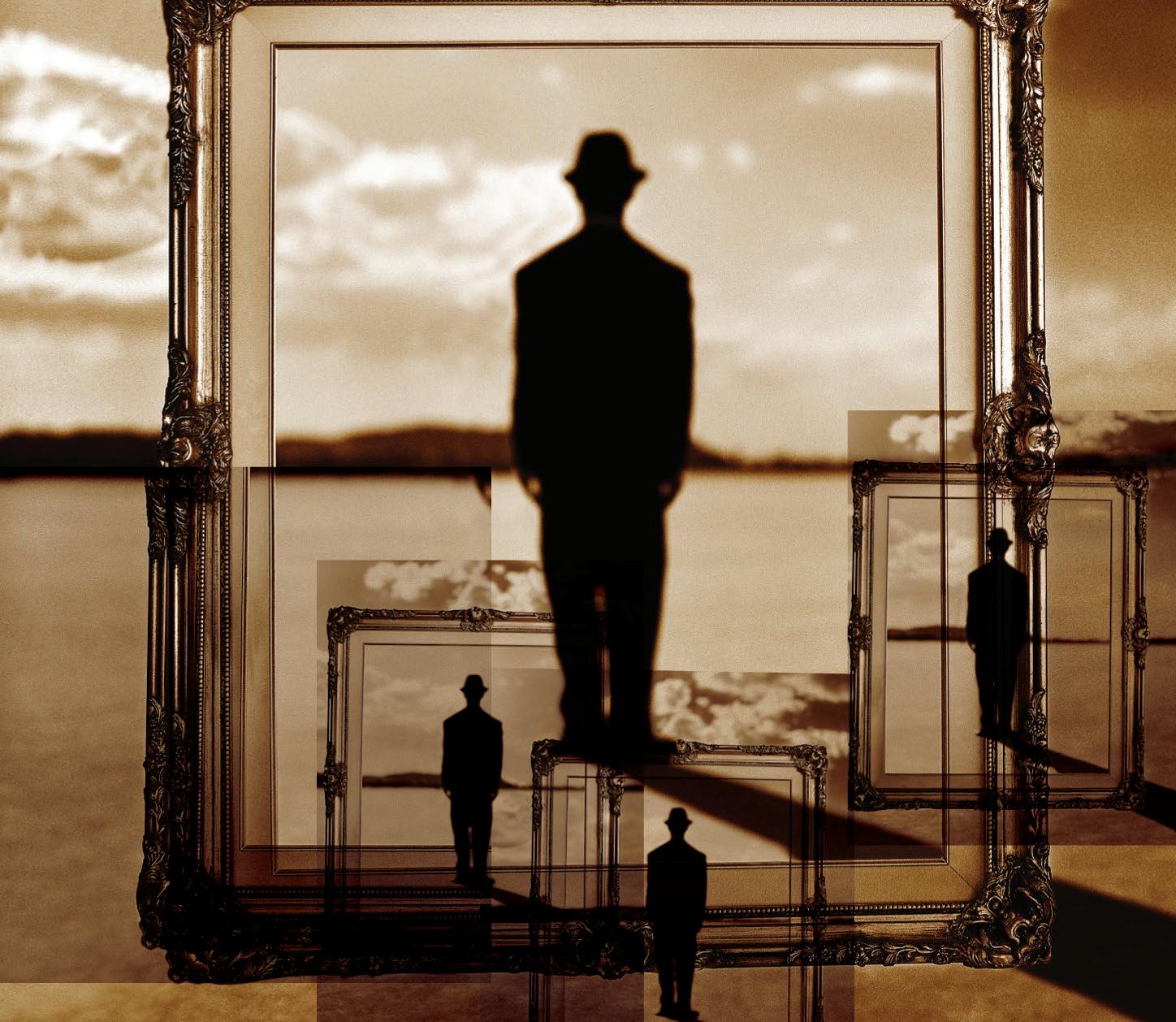
Situating itself in film’s visual narrative, Mise-en-scène: The Journal of Film & Visual Narration (ISSN 2369-5056) is the first of its kind: an international, peer-reviewed journal focused exclusively on the artistry of frame composition as a storytelling technique. With its open-access, open-review publishing model, MSJ strives to be a synergitic, community-oriented hub for discourse that begins at the level of the frame. Scholarly analysis of lighting, set design, costuming, camera angles, camera proximities, depth of field, and character placement are just some of the topics that the journal covers. While primarily concerned with discourse in and around the film frame, MSJ also includes narratological analysis at the scene and sequence level of related media (television and online) within its scope. Particularly welcome are articles that dovetail current debates, research, and theories as they deepen the understanding of filmic storytelling. The journal’s contributing writers are an eclectic, interdisciplinary mixture of graduate students, academics, filmmakers, film scholars, and cineastes, a demographic that also reflects the journal’s readership. Published twice a year since 2016, MSJ is the official film studies journal of Kwantlen Polytechnic University in Vancouver, Canada. It is included in EBSCO’s Film and Television Literature Index.

MISE - EN - SCÈNE 43
ABOUT THE JOURNAL

West Side Story : Characterizing the “Bad Guy” Through Color Subconscious Vol.07 No.01 | Spring 2022 44

Vol.07 No.01 | Spring 2022 46









































































